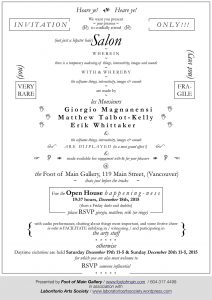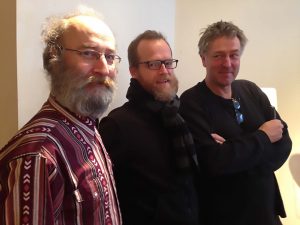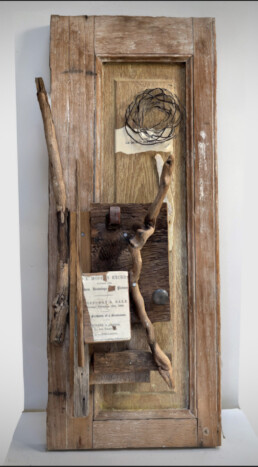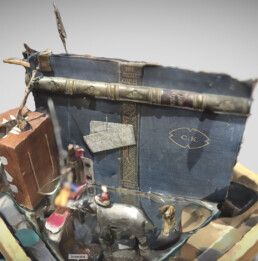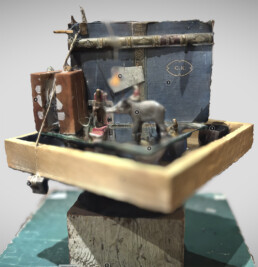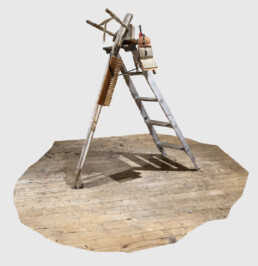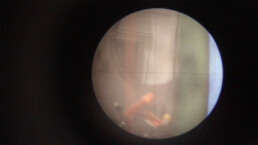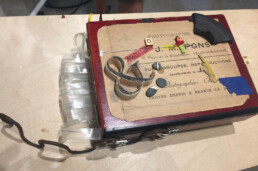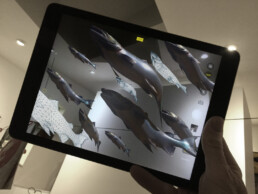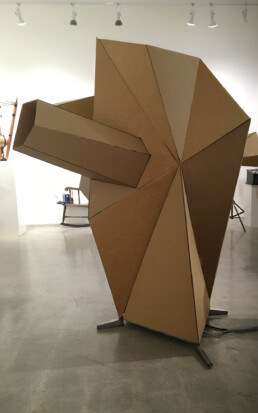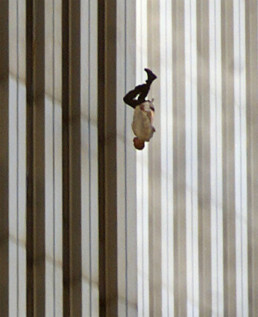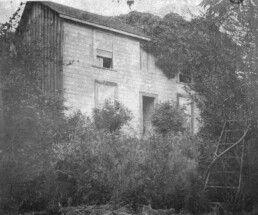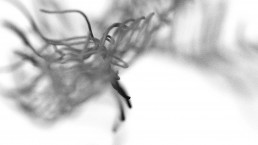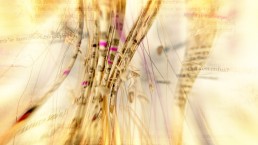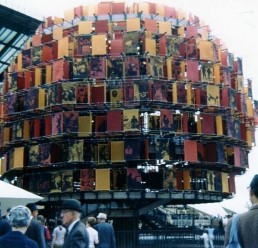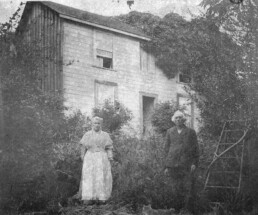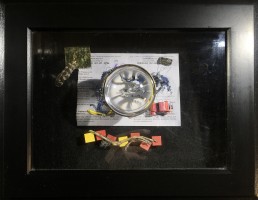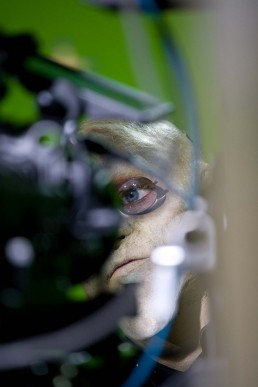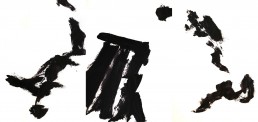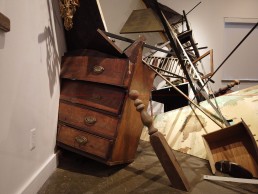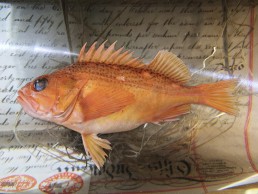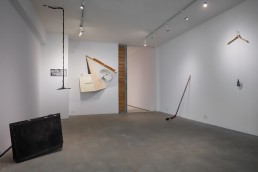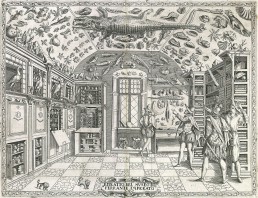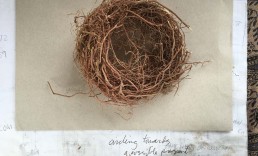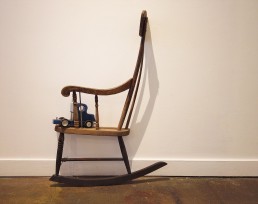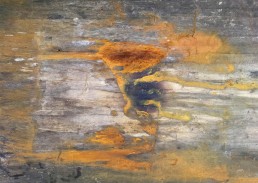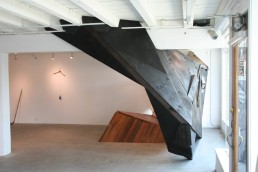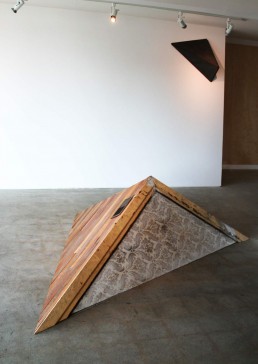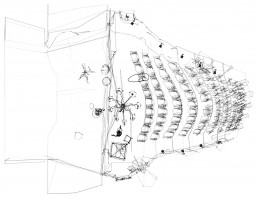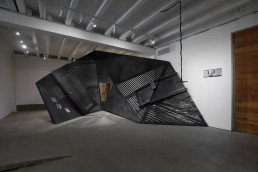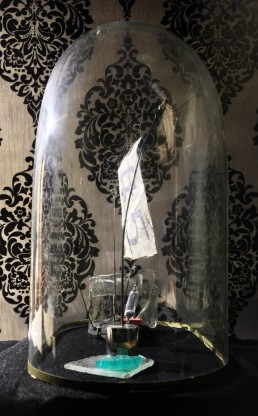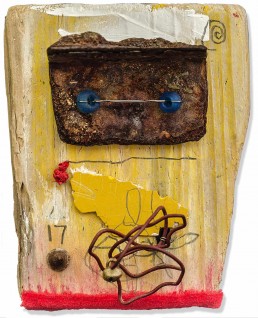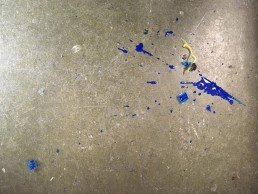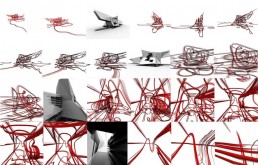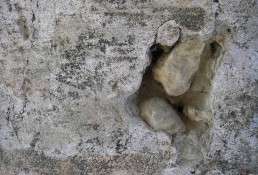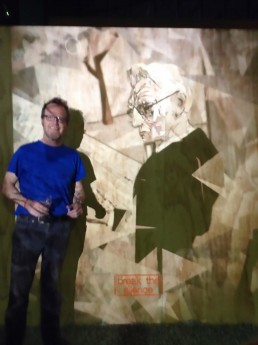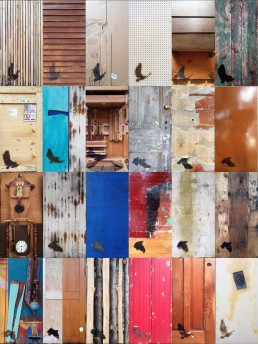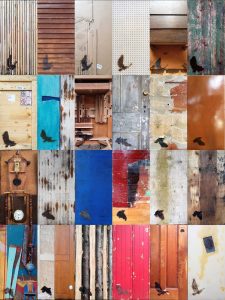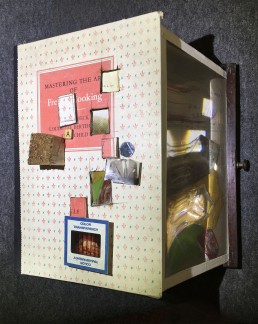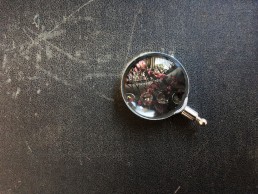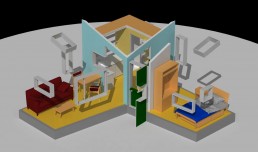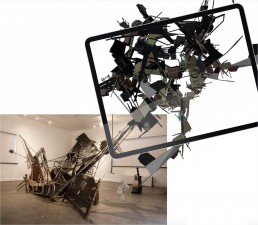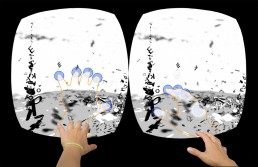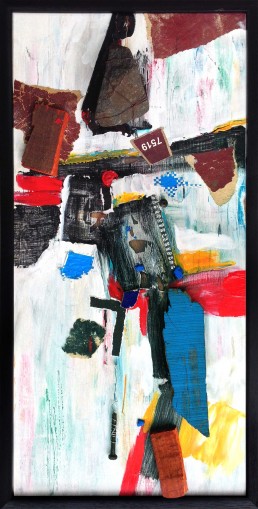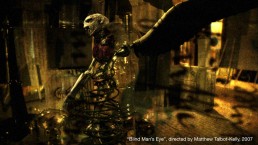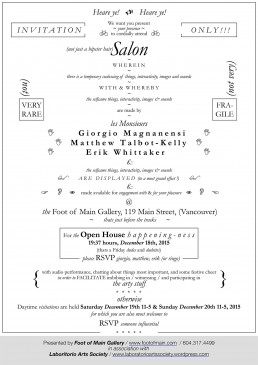Wood Architecture, assemblage, 2015
"Wood Architecture" is an assemblage work from a few years ago, built on a reclaimed wooden cupboard door.
Tilted Message by mtk537 on Sketchfab
Journey Around (w dais animation), assemblage, 2021
"Journey Around" is an assemblage work from a few years ago, built on an upturned box frame which sits on top of a rotating display, which sits on a cedar block. The assemblage inside this box frame in turn sits on a shard of mirror, on which the majority of the various found objects are attached. A collaged book cover, metal fragments, a lightbulb, various wires, a small wooden box with a bound rock inside, a bookmark, a lead elephant with rider, a fabric South American mini-puppet on a wire, a shredded one dollar bill, one hundred fountain pen nibs, paint and a latch lock.
Tilted Message by mtk537 on Sketchfab
Journey Around, assemblage, 2021
"Journey Around" is an assemblage work from a few years ago, built on an upturned box frame which sits on top of a rotating display, which sits on a cedar block. The assemblage inside this box frame in turn sits on a shard of mirror, on which the majority of the various found objects are attached. A collaged book cover, metal fragments, a lightbulb, various wires, a small wooden box with a bound rock inside, a bookmark, a lead elephant with rider, a fabric South American mini-puppet on a wire, a shredded one dollar bill, one hundred fountain pen nibs, paint and a latch lock.
Tilted Message by mtk537 on Sketchfab
Tilted Message, assemblage, 2020
This is a carefully poised assemblage work from a few years ago - consists of various found objects, including half a wooden step ladder, a piece of basboard, a childrens chair, a clamp, a hinge, a necklace, a First World War era miltary message pad, pencil and a shred of a rubber tire.
Tilted Message by mtk537 on Sketchfab
Scopetical
This post is about the Scopetical (in)curiosity in my recent Absurd Museum: "Doctor Kali Gehry's Cabinet of (in)Curiosities and Ecstatic Nonsense"
The Scopetical’s civil engineering scope is “levelled” on a stack of paint cans. The scope is oriented to look at, by turns: a spinning foreground (in)Curiosity; a suspended dirt covered glass window; a ridiculously reconfigured lego toy sitting on cardboard shelf cut out of a cardboard panel; a shaving mirror attached to a far wall which in turn reflects a looping animation playing on a perpendicular wall. The viewer can "move" back forth through the space of the exhibition by manually changing the depth of focus on the scope. The effect is lovely - haunting, painterly, evocative.
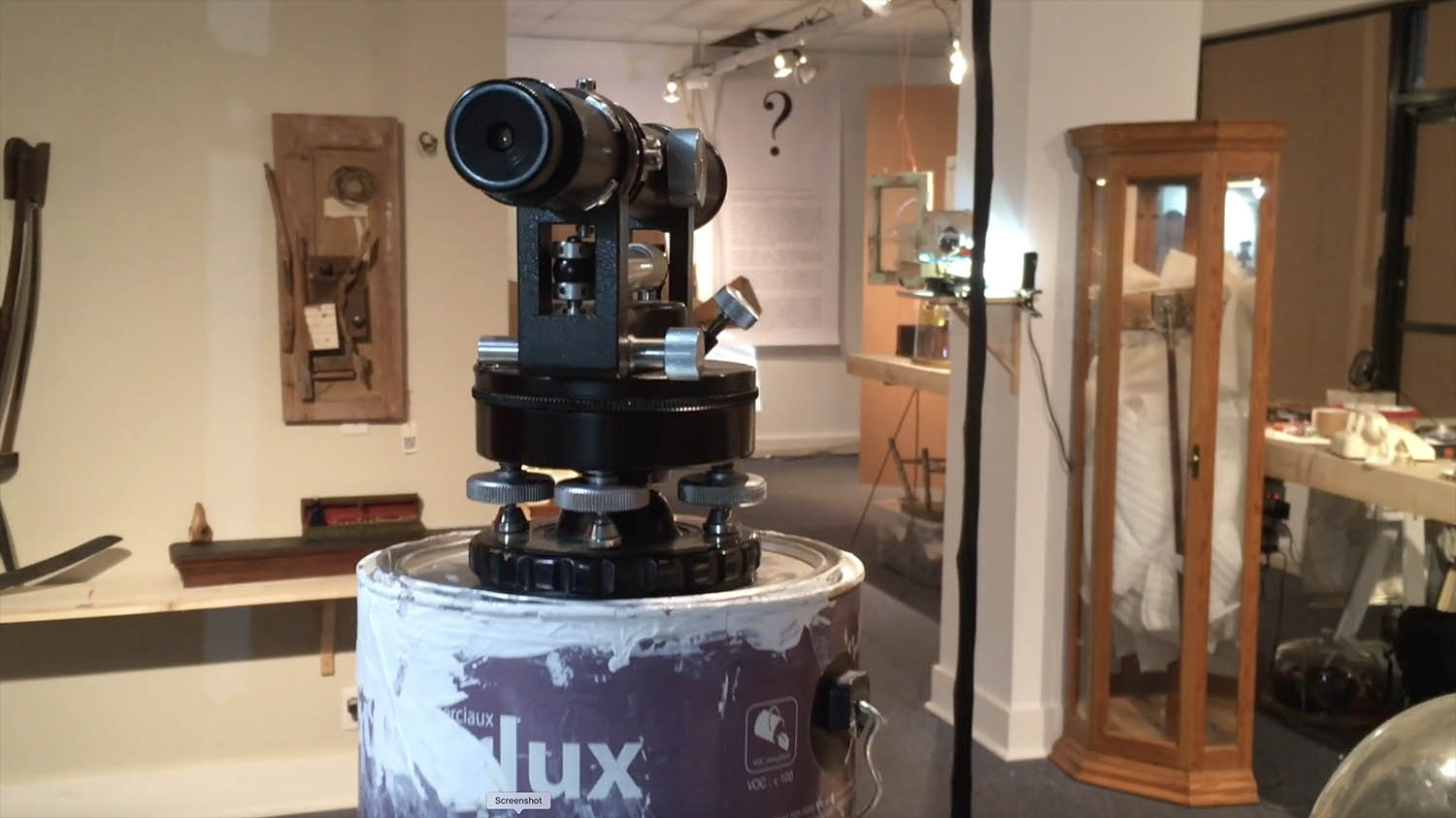
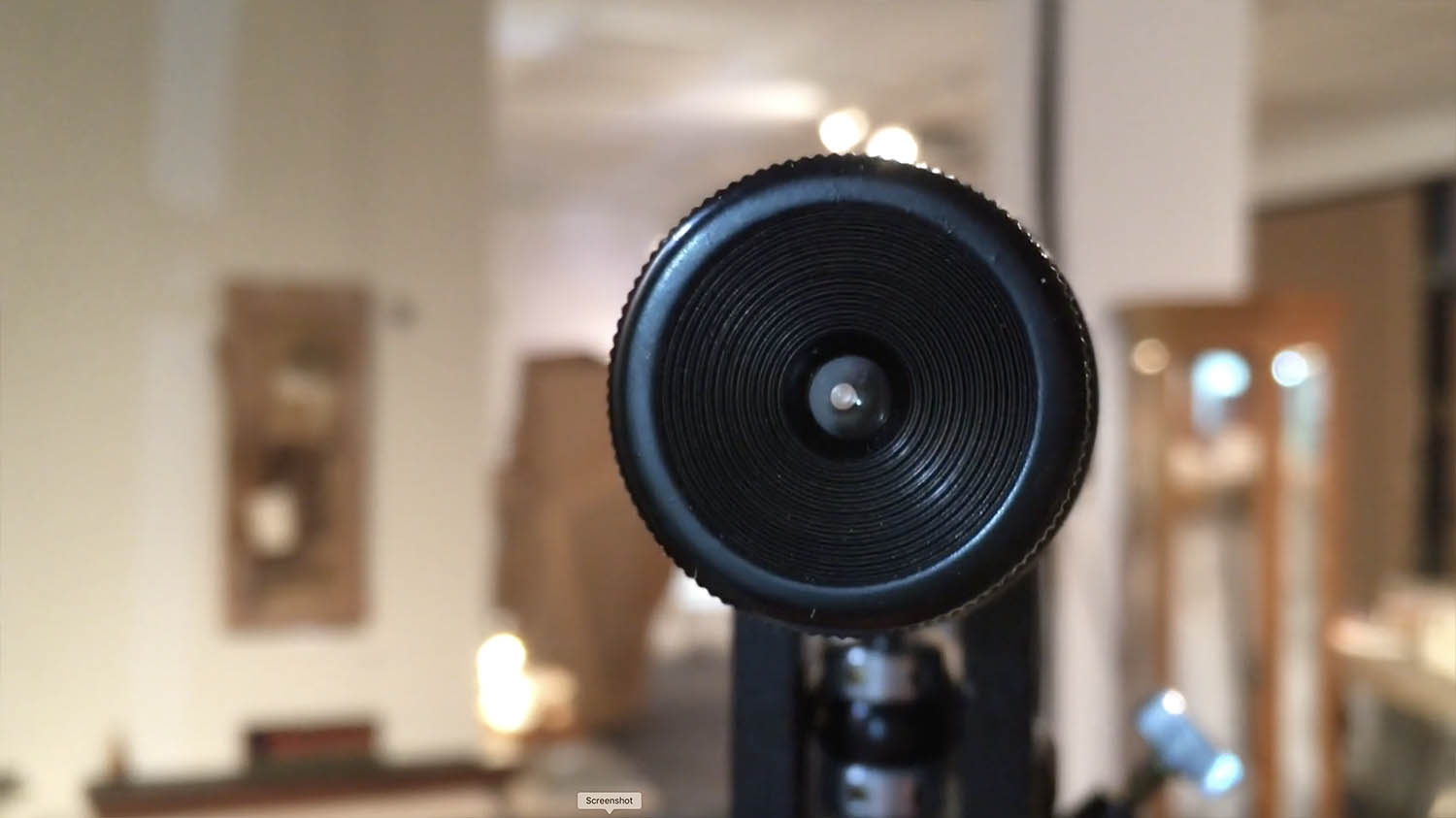
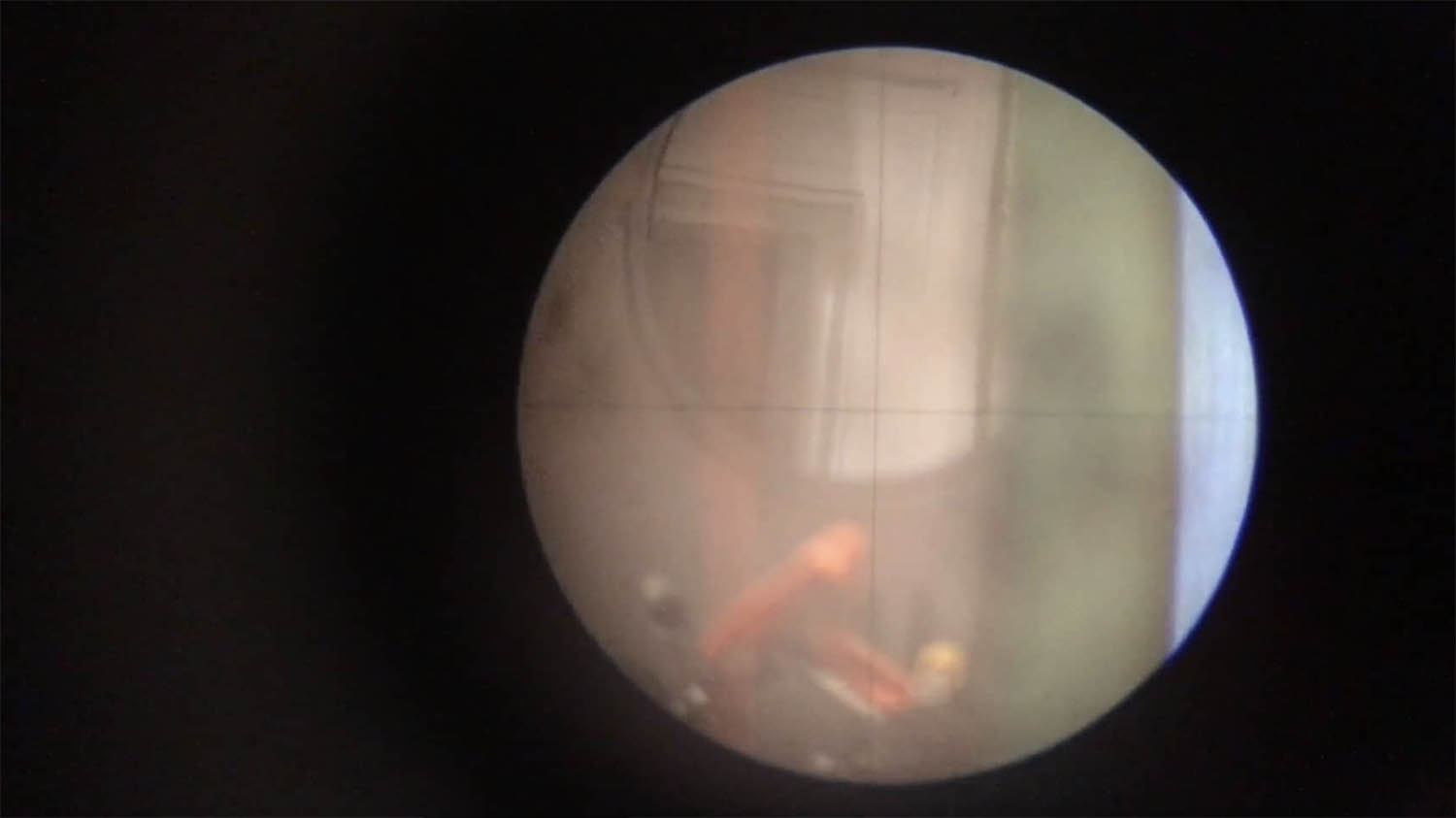
Sound Collage Book Box
This post is about the Sound Collage Book Box (in)curiosity in my recent Absurd Museum: Dr Kali Gehry's Cabinet of (in)Curiosities and Ecstatic Nonsense.
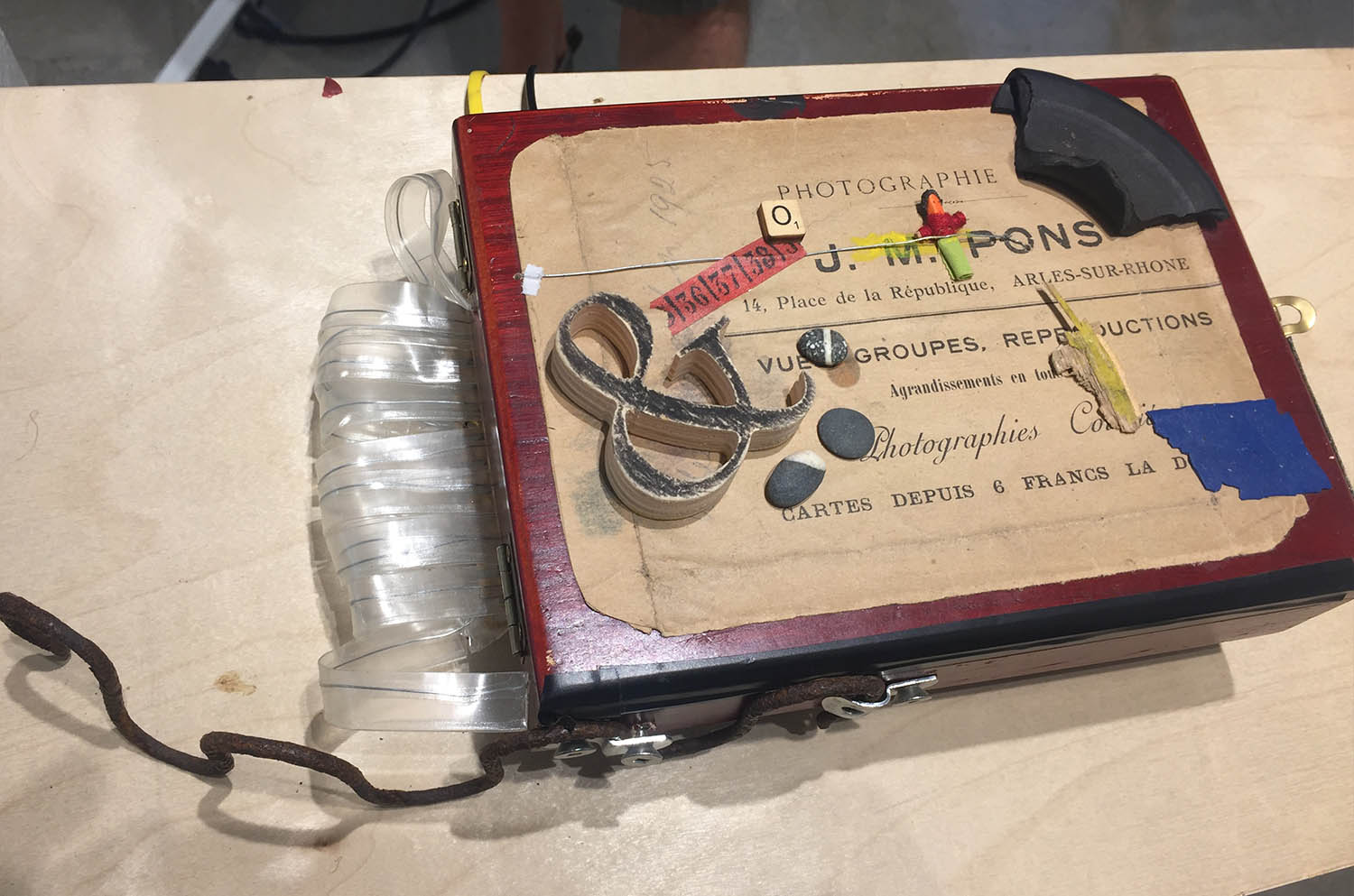
Sound Collage Book Box started as a collage of a thrift store acquired loose bound book of 1950s photographs of unknown people. I ripped, glued, scratched and combined this book over a period of months, eventually causing the spine of this book to give way. Intending to replace the spine, and having just started to play with an Arduino-like audio card, I decided to make a metal spine, and bolt the book inside a cigar box while wiring page turning handles on the backs of the pages so that as the pages are turned, a new sound is triggered to accompany the viewed page. The sounds themselves intersect/collide with the imagery of their corresponding page, at times jarring, at times complimentary: bubbling water, road traffic, CB noise, sonar. When the project's the cigar box is opened and closed, a creaking heavy steal door plays.
Video to come.

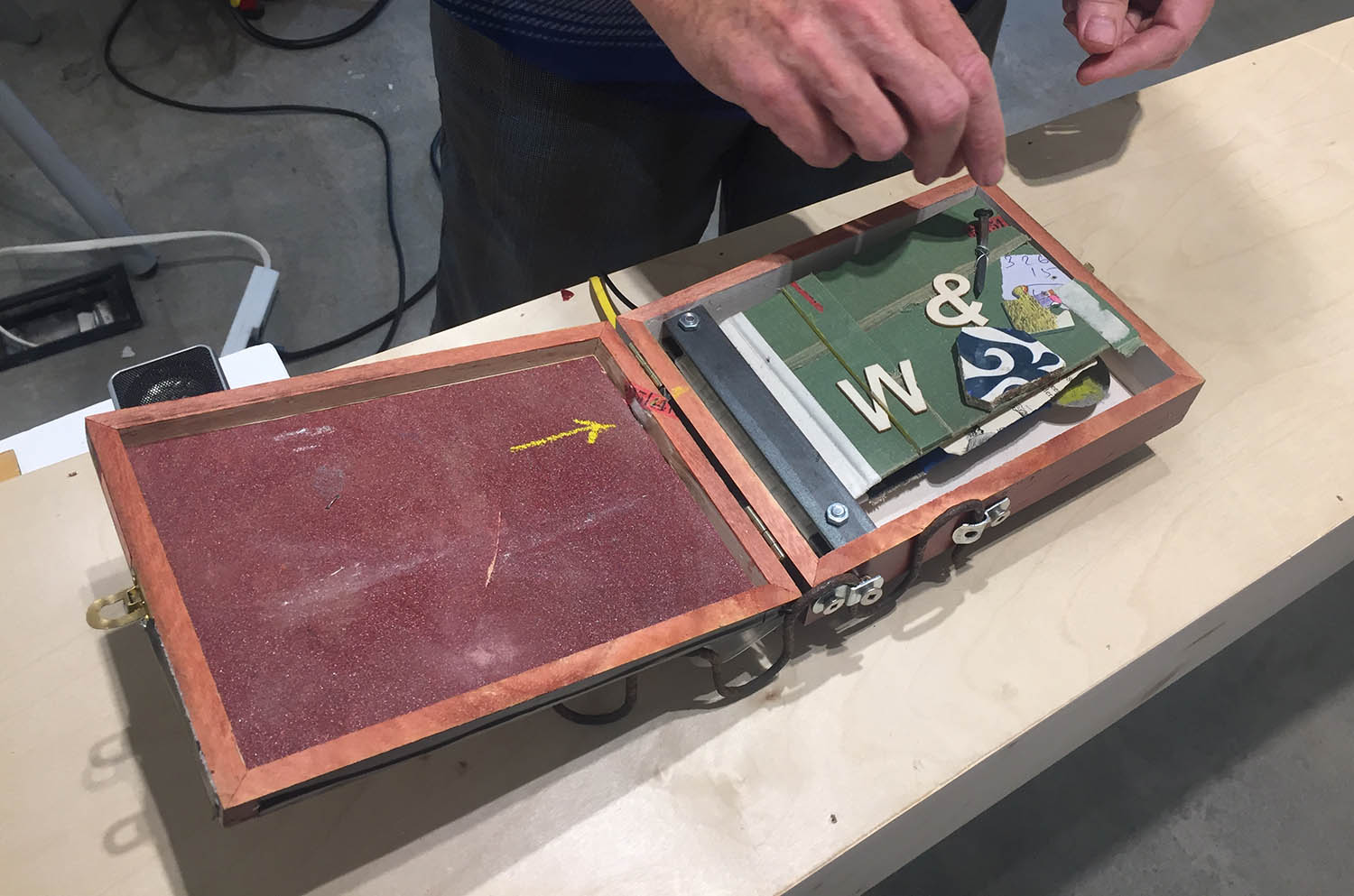
AR Cabinet
This post is about the AR (in)curiosity in my recent Absurd Museum: Dr Kali Gehry’s Cabinet of (in)Curiosities and Ecstatic Nonsense
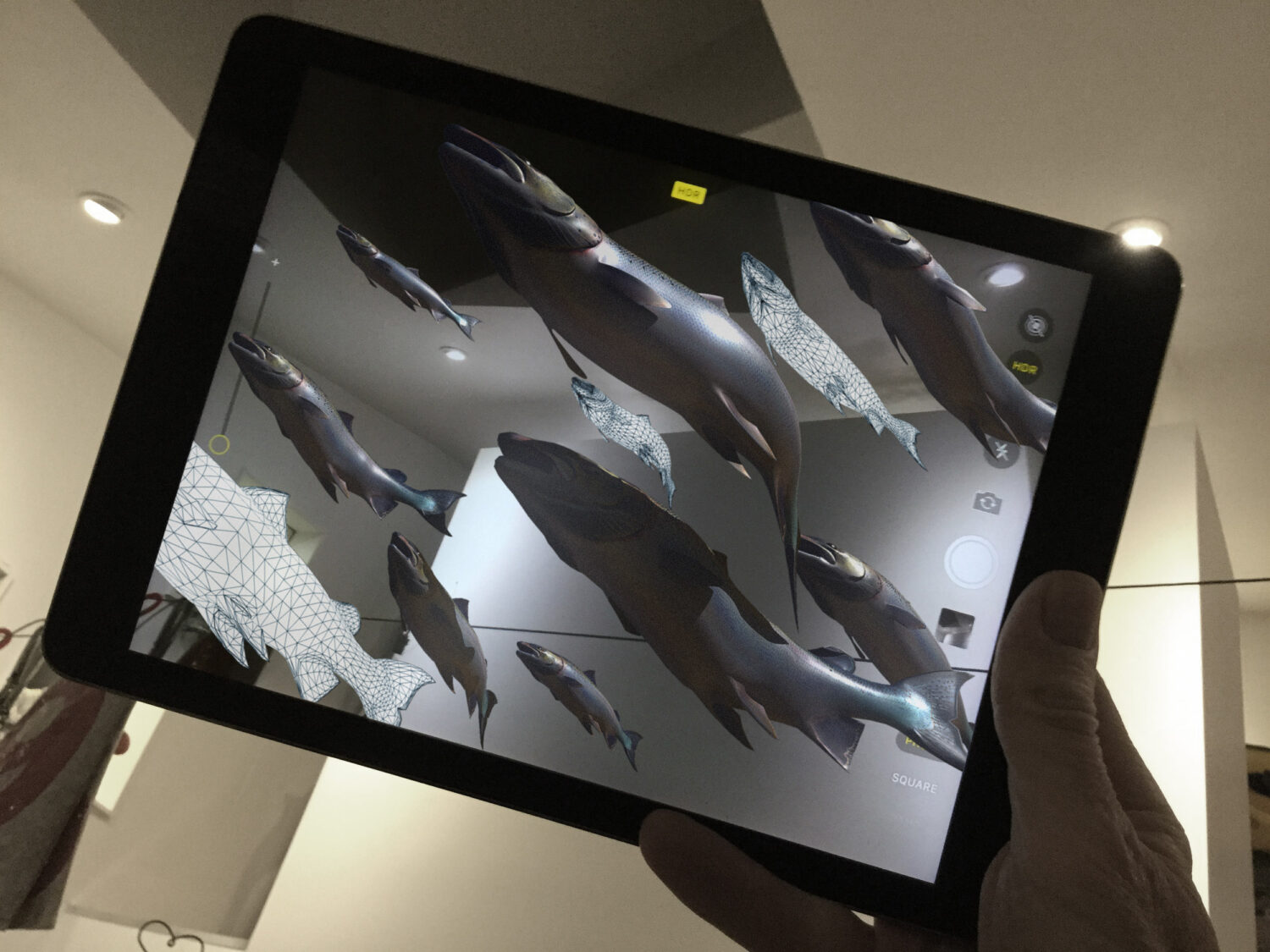
The orientation and trigger for this AR overlay experience running on a dangling iPad is a small wooden box with a Dr Seuss character and a roughly painted black cross. Holding the iPad while walking around the gallery space, the viewer can see a spatially registered and oriented digital overlay that seems to follow the users movements. Multiple digital worlds can be thus seemingly conjured inside the gallery, triggering both wonder and amusement.
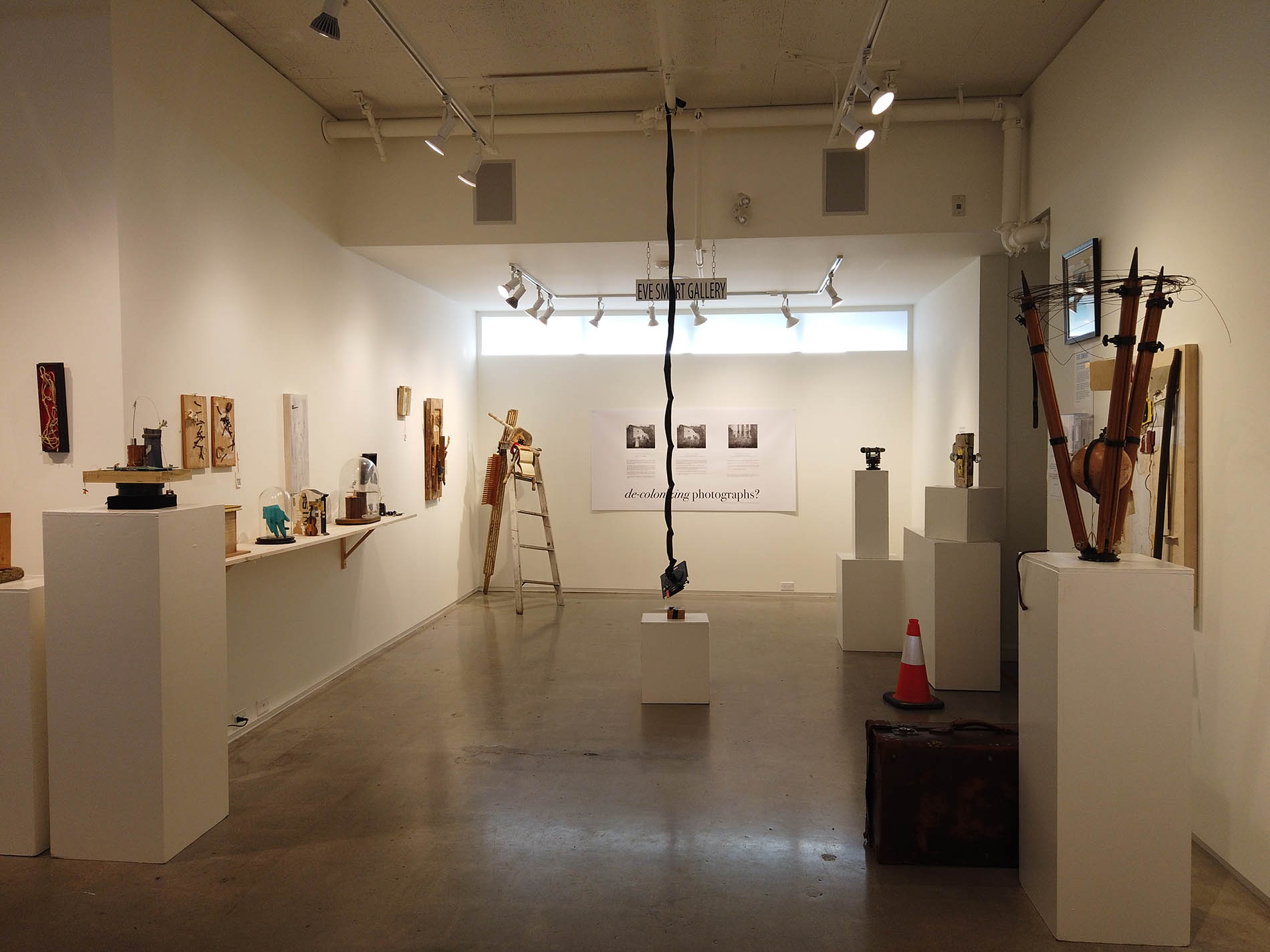
...for the Melancholic (anti-persepctive device)
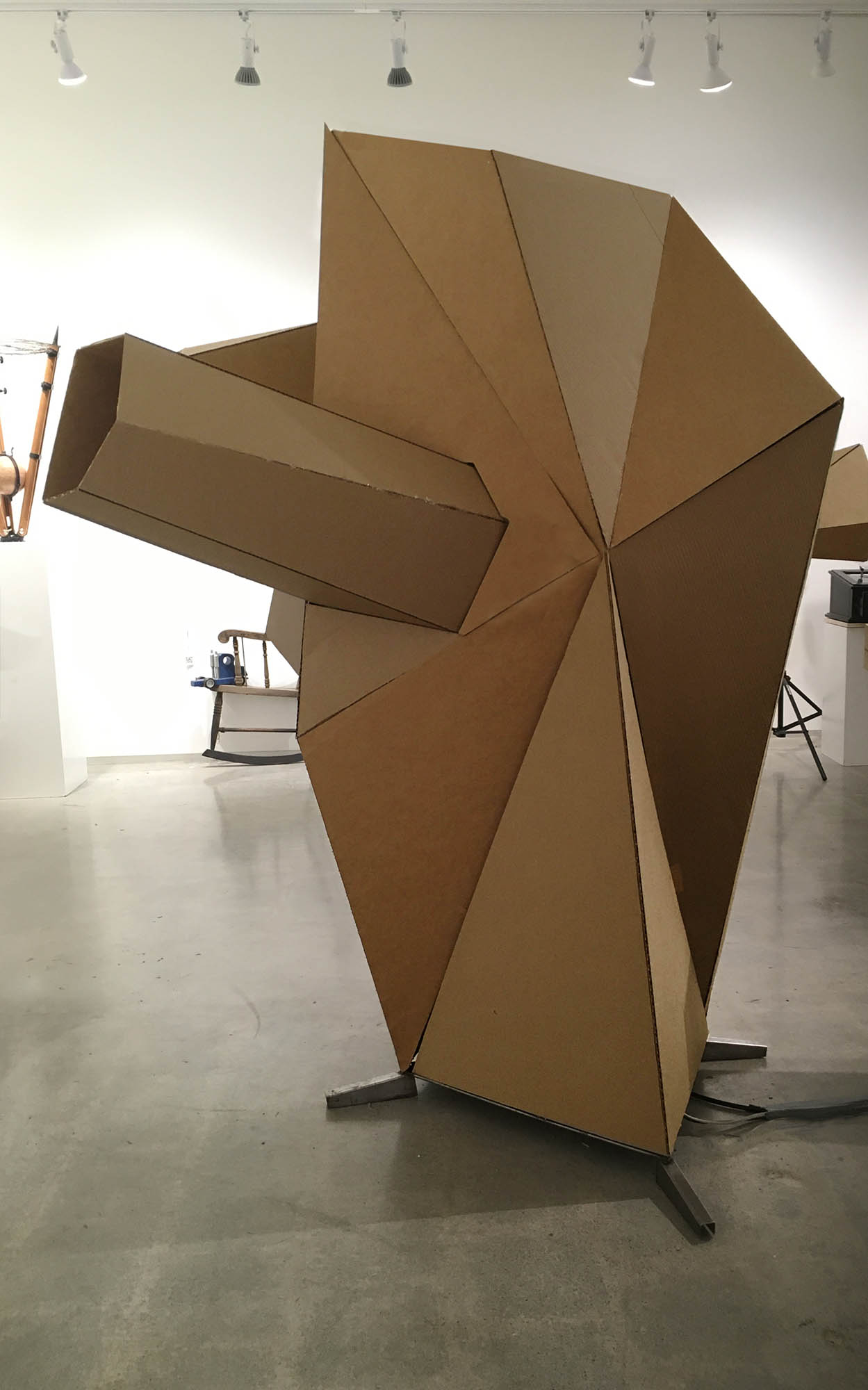
This is a stand alone five sided faceted cabinet. It consists of a cardboard covered steel frame housing five varying sized deeply set five sided digital windows, each displaying a different perspective of slow motion looped animation of an undefined organic form.
The concept is that the viewer will reassemble the five views of the form into an implied whole, like a five shot sequence of film.
I suppose in some ways the idea came from seeing Gary Hill's amazing video work, "Inasmuch As It Is Always Already Taking Place", in the early 90s at the sorely missed (Ydessa) Hendeles Gallery in Toronto.
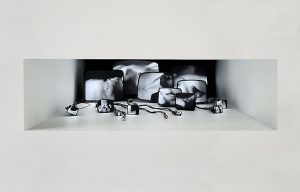
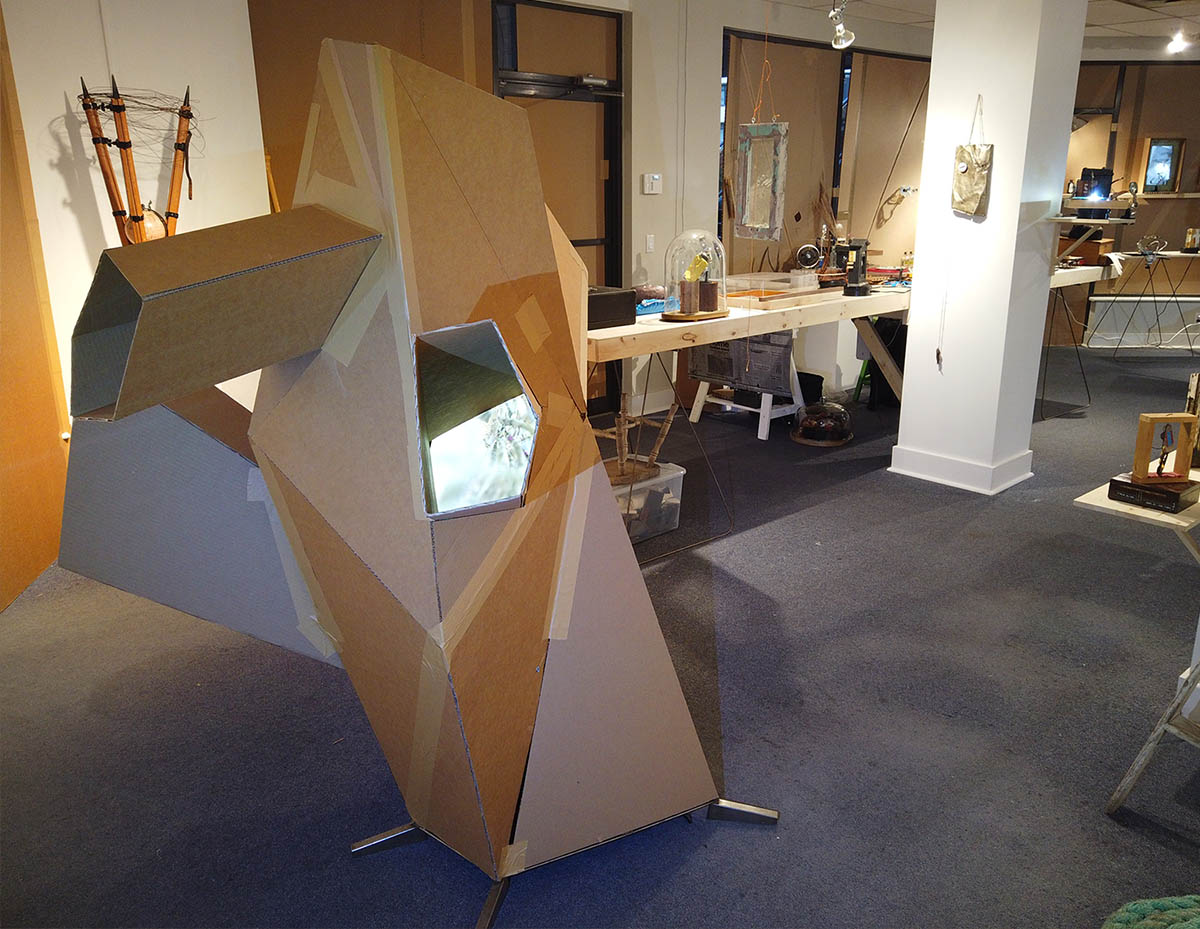
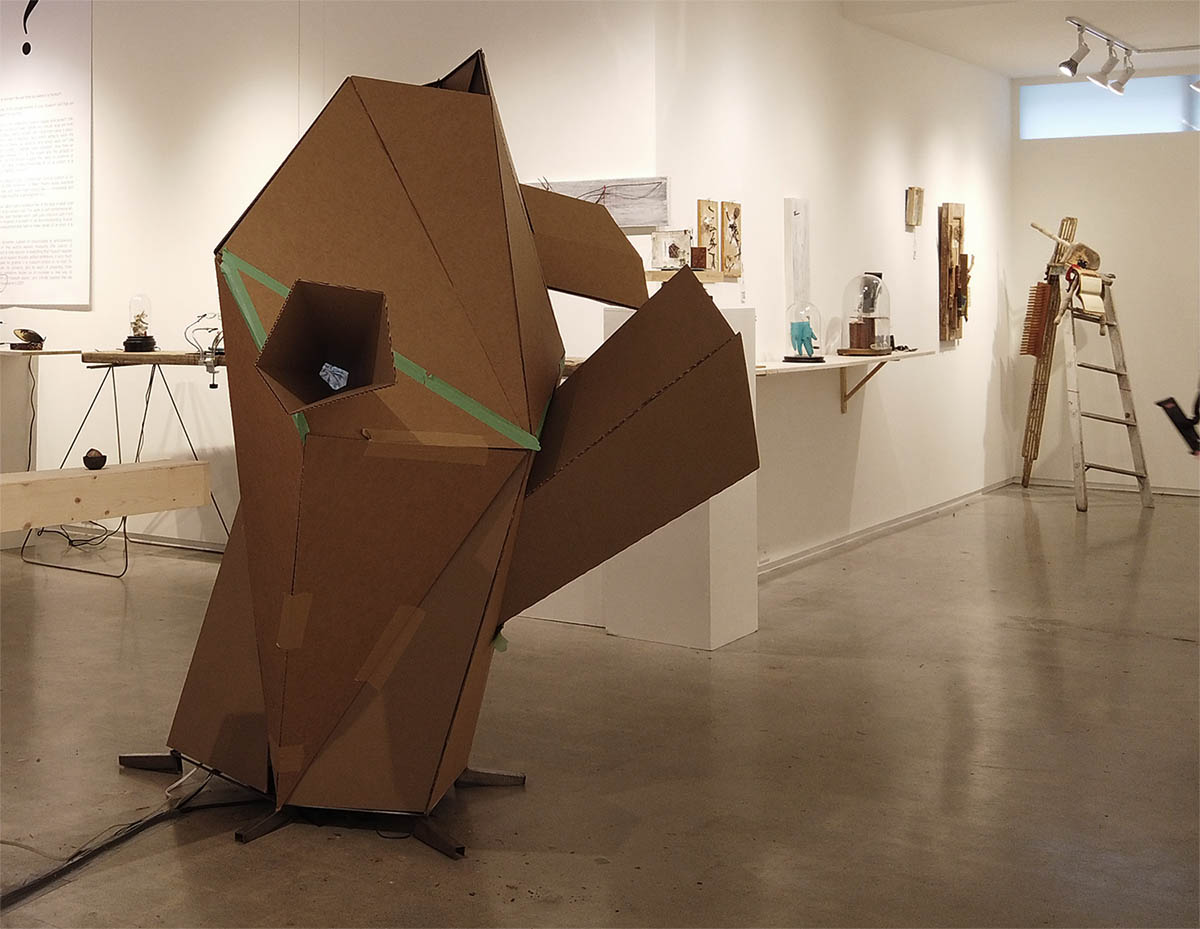
A view of the steel framework for the digital aquarium, welded by Nolan at Hinterland Design in Vancouver:
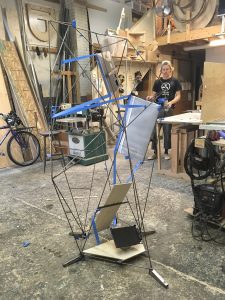
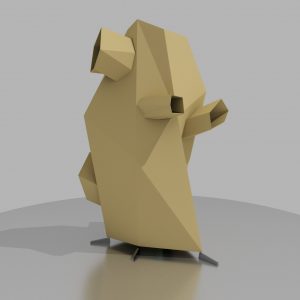
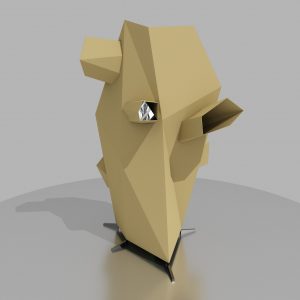
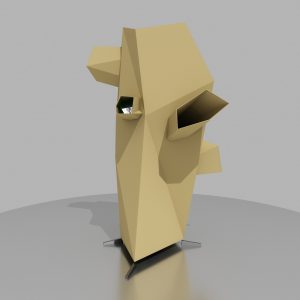
falling man
A heart wrenching photo that asks many questions of us all...
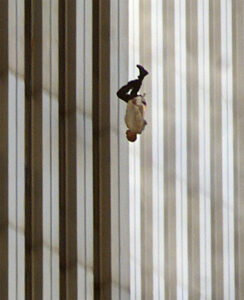
Of late, I have been reflecting on images, in particular the associated language of "taking" or "capturing" photos and the inter-related but possibly impossible idea of de-colonizing photos (or a museum collection). My earnest but inadequate suggestion for "de-colonizing photos" is to remove the colonizers. Of course, fundamentally, this changes little. But, perhaps, and this is my hope, it might open up some space, and perhaps another way into the important conversations around "de-colonization".
But what about contemporaneous photos that provoke contemporaneous pains? is "removal" or subtraction, a valid response? I am ambivalent in my answers...
This is a thought provoking article about the power and pain inherent in the uncertain certainty around the veracity and lies of a photograph:
https://www.esquire.com/news-politics/a48031/the-falling-man-tom-junod/
Dada is...
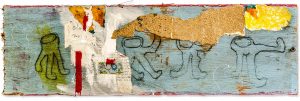
... not from that part of the brain.
... picking strawberries with bullets.
... knitting furniture for a convention of snails
... Further Decolonizing the Mr and Mrs Gibson Photo
A Museum 3.0 Exhibition Example - "Decolonizing" a colonialist photo, Part 2
In my earlier "Decolonizing a photo of Mr and Mrs Gibson" post, I found a public domain photo from the Vancouver archives, that is said to show Mr and Mrs Gibson, the "founders" of their namesake town of Gibsons, standing in front of their homestead house. I removed the colonizers, and rechristened the photo as "Wild cat in front of a home in Gibsons".
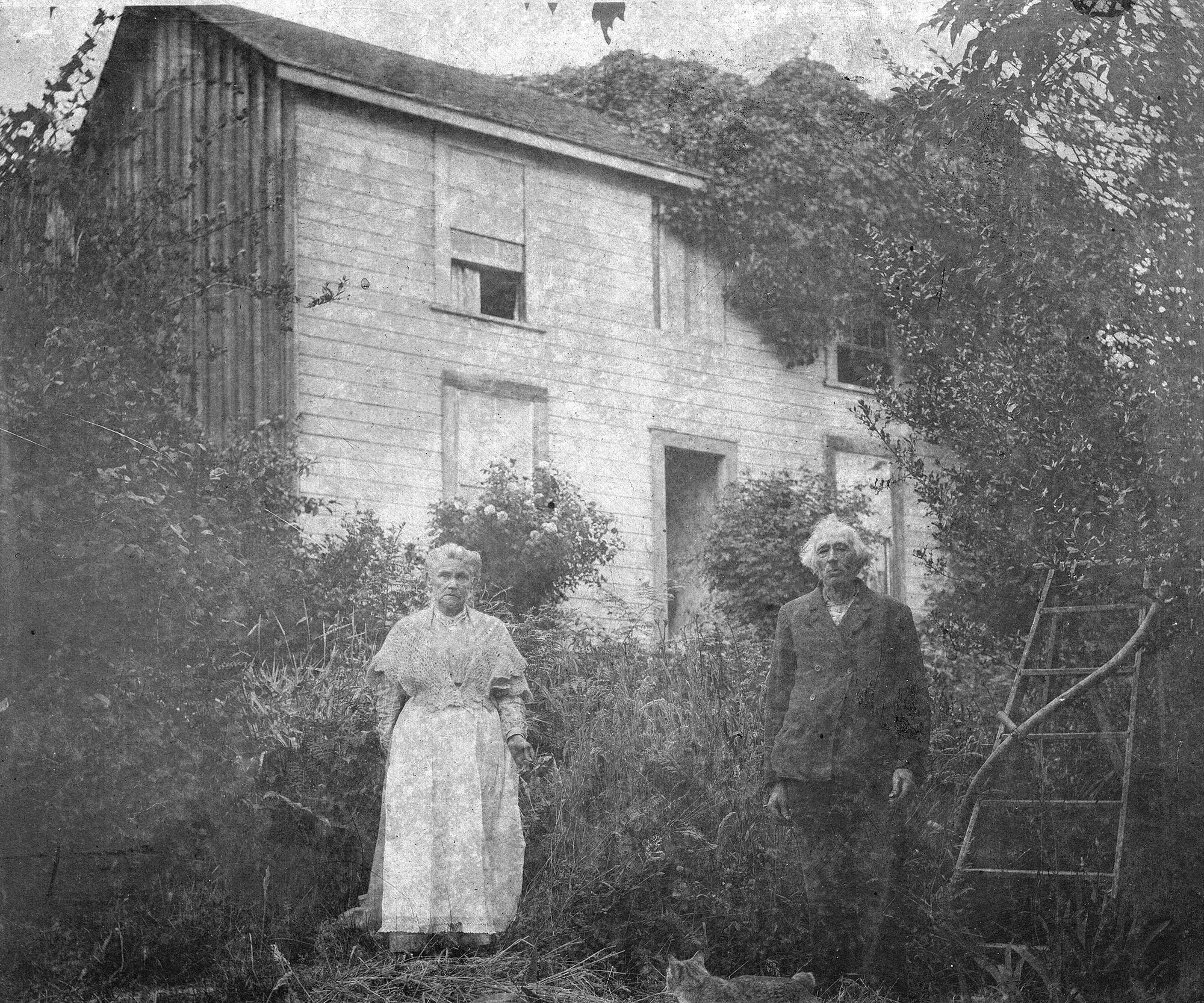
... thus became...
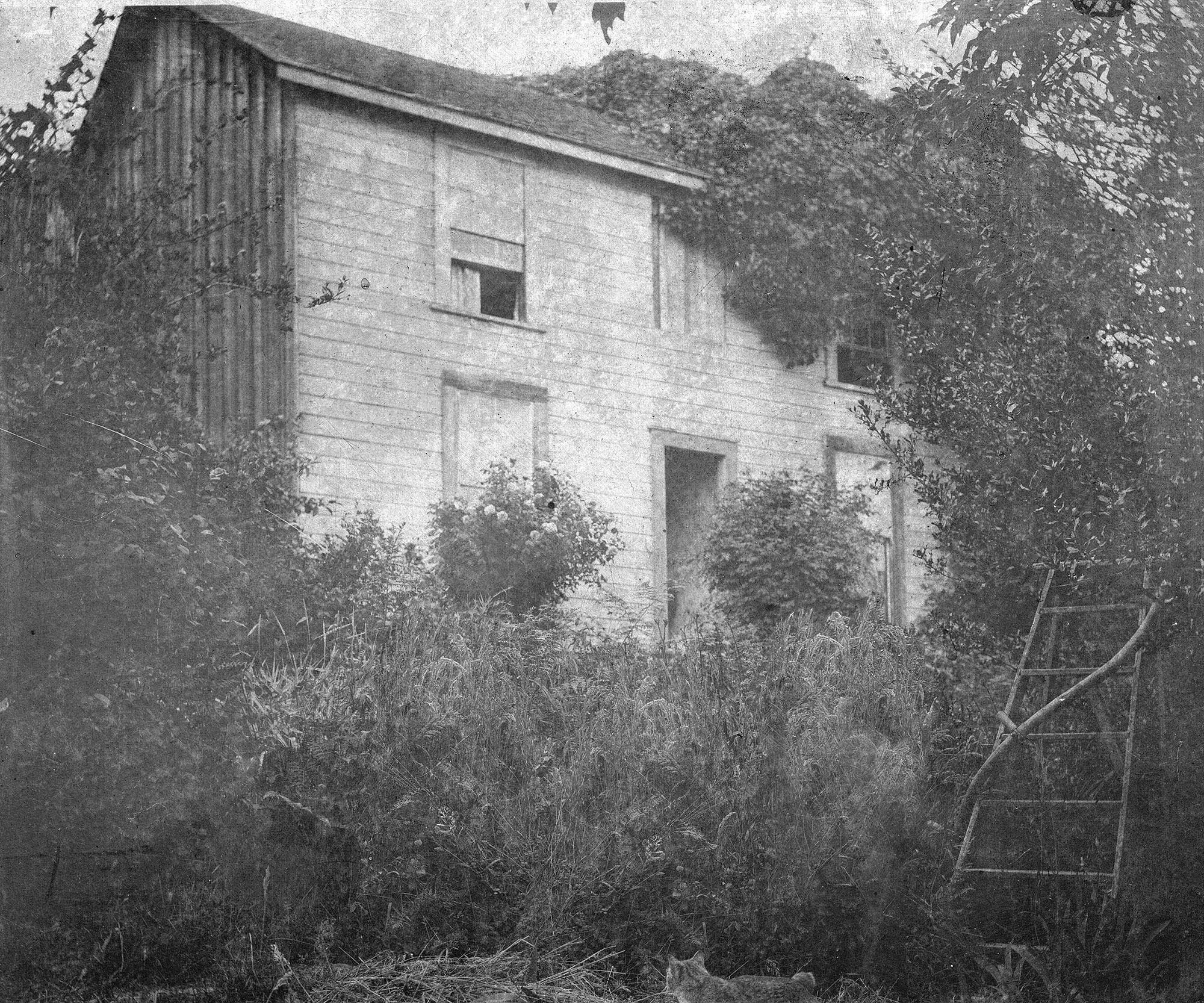
At the end of this initial decolonizing a photo post, I suggested I will do a second stage revision, where the tools and their house are in ruins, as if the homestead has been abandoned. Instead, this evening I decided to go further with the image, and remove all evidence of the Gibsons presence, by restoring some mature cedars on the site of their house.
So "Wild cat in front of a home in Gibsons" becomes...
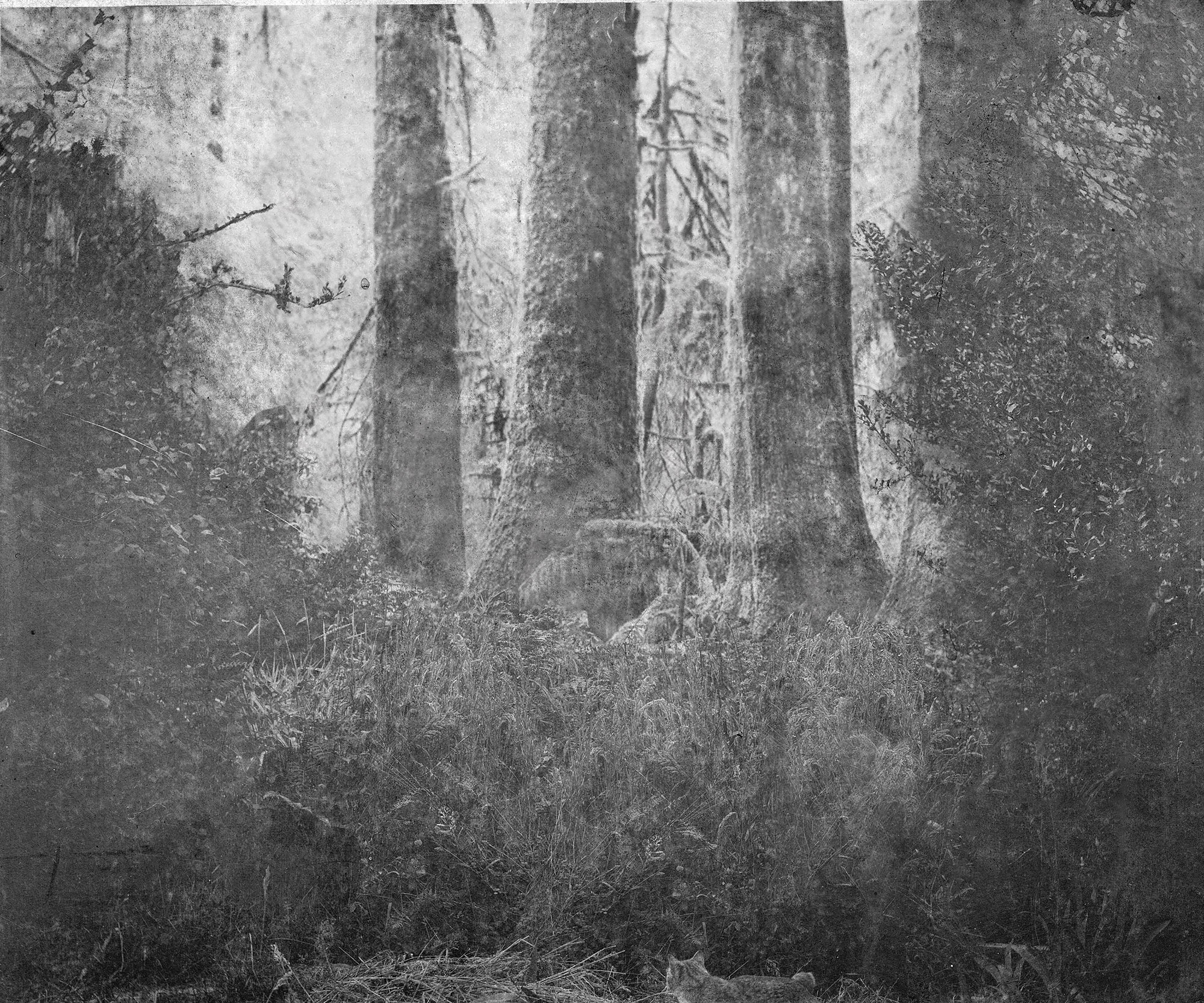
(According to the Gibsons wikipedia posting, the Sḵwx̱wú7mesh oral history tells that the region around Gibsons was the birthplace of the Squamish people after what is called The Great Flood.)
Now I feel like the image is more credibly "decolonized".
Note - the original source image and this digital erasure work has been done at a decent resolution. I have radically reduced the dimensions and added heavy compression to these images. If anyone would like to see the full resolution versions, drop me an email, I am happy to send them on to you.
Answering questions...
These questions were posed by my friend Julia Pileski, and answered during our many interesting conversations and email exchanges. I met Julia during an artist-residency I did at the Oxygen Arts Centre. Julia is a Nelson based Traditional Chinese Medicine practitioner.
What is your perspective on life? How did you develop this perspective?
I would describe myself as an absurdist that is interested in the possibility of presence.
I think the how’s of this development were many and varied. For example, starting as a boy of 15, I have experienced a comparatively large volume of deaths in my life. By the time I was 23, three of the eight or nine kids from our core group that had shared classes since we were six or seven, were dead. I asked, in many different voices from different psychic places, what is our explanation for death? of course, providing an explanation of ones continued validity/relevance even in death forms the basis of all religious belief systems.
What do you intend to communicate in your work?
A playful sense of the absurd. To be human is to be aware of our absurd condition - to have human consciousness is to be cognizant of our mortality.
Presence. Remembering to be present. Live in the now - not in the past or the future.
Becoming aware and easeful of the nothing.
Allow and embrace randomness, accidents, chance, serendipity.
How would you describe yourself and your style as an artist?
I would describe myself as: I am of average brain, average health, average disposition, average looks, average creativity, average humour, average tolerance - above average curiosity and determination.
I describe myself as an artist/architect/film-maker/exhibition designer.
or
a spatial & temporal mixed media artist.
or
a conjurer/trickster/fool.
What drew you towards these art forms?
I feel there is a direct link from the varied things I do to my interest and training in architecture. I was never convinced about being a professional architect, i was most attracted to the training of an architect. In pursuing an architectural education I understood the training as the most well rounded education available. During my training, I began to recalibrate my interests away from the design of architecture. For example, I began to recognize the folly of an individual being asked to design complex architectures like a modern Carnegie library, interpretive centre or redesigning a city of millions, as architecture is the most collaborative of art forms. I became less interested in the formality of arriving at specific architectural designs - which when unbuilt might be dismissed as mere graphic lines or “paper architecture” - and more interested in the effects of time and movement through space. As well, I became more interested in the narratives surrounding impractical and informal architectures. So, less focussed on the pre-concluded program and predictable rational planning of architecture and more about various unpredictable choreographies. This temporal, spatial and choreographic interest remains a recurring theme in my works. Another draw during my university was being re-exposed to and starting to experiment with chance processes, found images and collage/assemblage techniques.
What or who has been the main influence in the development of your practice?
I think the main influences have changed over the course of my life.
When I was a young boy, I had a very influential public school teacher, Dorothy Elkington, for grades 1, 2 and 6. She encouraged us to explore learning through drawing and story-writing. She also taught us to meditate. From these foundational years, Dorothy remained a life-long friend and mentor until she died a few years ago.
One influence that comes to mind is that my mom had a number of friends that were architects and, though he wasn’t around during my formative high school years, I knew my dad was trained as an architect. There seemed to be a sophistication, intelligence, compassion, and humour in the worldview of each of these five men and one woman that really struck me and one commonality was that they were all trained as architects.
Before I decided to study architecture, I worked with a young architect/artist/professor (Dereck Revington) who was influential in articulating to me the benefits of an architectural education. He remains a good friend and mentor.
One profound moment I recall happened when my English artist grandfather visited our home in Toronto when I was ten. He was a superlative drawer. I remember being spellbound sitting beside him watching him draw, conjuring birds and creatures. This is my only memory of him, he returned to England and died within six months.
As I got older and after my father died, in addition to this grandfather, I really began to explore the reality that this grandfathers father, father-in-law, and grandfather were professional artist painters. In this sense, I began to understand being artistic is a large part of my ancestral inheritance.
Please describe the top 3 most influential personal growth moments/psycho-emotional breakthrough moments of your life. In what way did they influence your life perspective and artistic expression?
- The car accident
- Cranio-sacral healing sessions with Mia Kalef after the car accident.
- Kissing the forehead of my dead father
- Doing ayahuasca in the early '90s
- Going to my Irish cousin Diurmuid’s funeral with my Mom
The second part of this question is kind of answered below. But here goes
- I learned to be present. Though i don’t believe in God, the result of the accident was like a big fist came down on top of my head that slammed me into the present tense. a command from on high: “dont worry about the past that we can do nothing about, nor worry about the future that may never arrive, the continually unfolding present is all we have.” the present is our only true reality. and the one known truth about the present is that its continually changing. This bashing into presence was complicated and compounded by the fact that i still can’t remember the car accident. i can remember the lovely moments before and the collateral damage after, but nothing reliable about the 15+ minutes either side of the event. this was very problematic until I accepted the responsibility of the accident. though it was truly an accident, i was still responsible. consequential accidents are no different from inconsequential ones, accept for their outcomes. each are accidents, random alignments of specific events. concluding its an accident and accepting responsibility for something that I have no conscious awareness of, that I have no visible injury from, where I relied on others to relate to me their version of events was a major challenge. pretty absurd, pretty Kafka-esque.
- Mia was such a benevolent source of healing. I was introduced to her at just the right moment, earlier i wouldn’t have been convinced i needed help and later I might have been beyond redemption. when i shadowed her door, i was ready to work! she supported me in reassembling myself after i admitted i was pretty fucked up from the accident. I describe crania-sacral work as a combination of super slow motion chiropractic adjustments and crossing the river styx by hand propelled boat blindfolded, where your unconscious body leads and she follows and supports. its uncanny, the way my body knew what it needed to do to heal, attended by Mia in such a concentrated and generous way. i loved that Mia agreed to work with me for consecutive six plus hour days, the unusually compressed timeframe allowed me to become a new man - a newly integrated man - in a very short while.
- I was in Ireland making my first film when my dad died, in his flat’s kitchen, in Gibsons. I include this psycho-emotional moment not because I felt guilty being away from him in his last moments, although there was a flicker of that. it was more about experiencing the finality of his death. despite arriving only 36 hrs after he died, the cold remoteness of the kiss, the complete absence of life in his skin, sticks with me to this day. Though i had brushed up against death many times before his death, for a son, the death of ones father is especially profound. Despite being quite different in personality, in physique, in temperament, never-the-less, I was his mini-me. The aftermath, of clearing out his apartment was also important. For a life-long creative man, the lack of much tangible material output to “hang on to”, was very instructive for me. As a result, I redoubled my efforts to keep my house come hell or high water. As well, to leave at least one thing for my children that was reflective of my particular passions and interests, something I carefully and lovingly created against many odds… This in turn, became a very large impetus for my first film, Blind Man’s Eye. I would love to have shown him this film….
- What can I say? ayahuasca stopped me in my tracks ! it confirmed my previous intuitions that space and time are not linear, that i had gleaned through meditation and “dabbling” with various other drugs. after doing ayahuasca once - I feel like I understood this powerful medicine in a deep way - I didn’t feel any inclination to do other hallucinogenic drugs for twenty years.
- My Irish cousin Diurmuid was killed in an early morning raid by a London swat team that was told to expect a firefight ‘cause they were confronting “Irish terrorists”. The situation was so fucked up in so many ways - socially, politically, emotionally - and its consequences were pretty devastating for the Irish side of my family. With me by her side, into this chaotic scene steps my mom, the matriarch & queen of our family, to bless and hold the family together. She showed me how to get all medieval - she introduced me to and demonstrated to me the powerful Celtic ancestral ways which could not be held back or down by the newer and more foreign Christian ways. Despite the enormous press and police presence, the numerous out of town attendants, the days before, after and the funeral itself played out like a medieval drama. I still feel like this profound time literally rearranged my cells - clearly calling me back to the olde sod to drink up these ways, like a salmon to its spawning ground.
Oculus Loop
This is a looping animation that will form part of one of the cabinet elements within my larger Cabinet of (in)Curiosities exhibition this coming September.
Digital Invisibility
Digital Invisibility
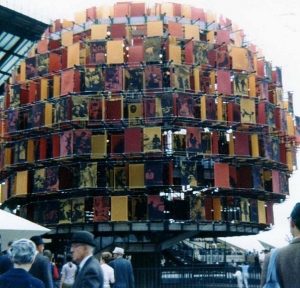
One unfortunate outcome of this digital age we live in, is that unless one has a digital footprint, for all intents and purposes, you barely exist outside of ones immediate family and social circle. Conversely, if one does have a substantive digital footprint, notably a large social media following, one’s “presence” can become global, having an outsize influence on society. In many cases, this notoriety happens despite these “influencers” having little discernible skillset beyond being famous or looking a certain way.
This digital divide is especially striking for my parents generation of creatives, as there is almost no record of their respective contributions, save for the odd analog newspaper or magazine mention on a dusty library shelf. Yet many of my parents generation of fellow creatives were intimately involved in varied and numerous fascinating activities, honing their skills, plying their trades, initiating projects in an amazing diversity of creative output over decades. In most cases, because there are no digital versions of their respective portfolios, appreciating their contributions is nearly impossible.
Accelerating in the 60s and 70s, there is little doubt Canada’s active promotion and embrace of multiculturalism attracted millions of would be immigrants. The charismatic charismaticprime minister Pierre Trudeau was a compelling spokesman who was instrumental in framing this social experiment, creating a seductive narrative for those who were considering immigrating to this relatively new country.
It was Expo67 in Montreal that put Canada on the international map as a forward looking land of hope and possibility for millions of new Canadians, especially numerous creatives. As well, the Ontario governments decision to create community colleges throughout Ontario offered non university post secondary educational opportunities to the curious beyond the 10% of the population who went on to University at the time. The creation of these community colleges also provided numerous opportunities for English speaking creatives and intellectuals, including new-Canadian ones like my parents. The late 60-early 70s of Canada was a boom for many young architects, exhibition designers, graphic designers, industrial designers, typographers, theatre professionals, writers, artists, musicians and more.
Unfortunately, today, for the overwhelming majority of my parents creative peers, there is scant evidence of their consequential contributions to Canadian material, creative and intellectual discourse. As their generation are now in their 80’s and 90’s, if they are still alive, the chances of their legacy’s never seeing the digital light of day are quite high. Meanwhile, we are bombarded by way too many intimate yet banal details of the typically superficial influencers that dominate our digital landscape.
Of course, this phenomena is not limited to a Canadian context.
One of the outcomes of such a disparity is we are overwhelmed and exhausted by the tweeting antics of the banal, the unimportant, the superficial, the inconsequential, and the unmitigatedly ignorant. We are drowning in a tidal wave of distractions, amusing ourselves to death. It would be great to swap out this outcome, by celebrating the legacies of relevant cultural contributors while "putting a lid" on the less important cultural drivers.
Decolonizing a Photo of Mr and Mrs Gibson
A Museum 3.0 Exhibition Example
As I expressed in earlier posts, due to my new work being a revisiting of the museum cliche Cabinet of Curiosities, I have been reflecting on museums and collections. In turn, this got me thinking about "Museum 3.0" and the possibility of "decolonizing" such institutions.
At the end of the day, though I love ideas, I also endeavour to be practical. So, rather than lobbing vague criticisms from the sideline, waxing poetically (or not!) about some far fetched or unrealistic notions of what should be done, I thought I'd explore an example of "decolonizing" a photo for a Museum 3.0 exhibition.
The problem with photos
As Susan Sontag pointed out decades ago, all photos come with inherent complexity and contradiction. "All photographs are memento mori. To take a photograph is to participate in another person’s (or thing’s) mortality, vulnerability, mutability. Precisely by slicing out this moment and freezing it, all photographs testify to time’s relentless melt." Also, the English language of photography points to the sense of it being an illicit activity - we "take" photos, as in we steal them. Curiously, we don't use more appropriate language like "construct" or "frame" or "choose" in relation to photography. In this sense, "taken" photos of colonialists is the appropriate documentary means as the colonialists themselves took the lands they called their own.
"Mr and Mrs George William Gibson in front of their home"
I found this public domain photo in the Vancouver archives:

It depicts Mr and Mrs William George Gibson, circa 1905, the namesake "founders" of the small British Columbia seaside town I call home. Of course, these lands have been inhabited by indigenous people - Sḵwx̱wú7mesh Úxwumixw - for millennia prior to the Gibsons turning up, unannounced and uninvited in 1886. And that is the point - these are the real deal, the Gibsons are tried and true colonialists.
I am intrigued by this photo. I am curious about the-arms-by-their sides formality, the sense that Mister just downed the scythe and his Missus came out of the house, the unusual physical distance between them, complete with their oh so serious demeanours. At the very least, they seem reluctant to be having their photo taken. Is it an obligatory photo? Even the cat seems surprised to see them side by side where they are. There is little sense of resolve - as if they are almost passive to their plight.
I find the composition curious, as if the "wilds" are going to swallow them and their homestead home up. I like to think they are barely in control of the “wild” around them, even in their homestead. They simply can’t keep up.
I love the varying depths of focus and quality in the photo.
There is an uneasiness in this photo. Perhaps I am betraying my predilections, but is the uneasiness that the photo has "caught" the Gibsons in the act of "taking"?
I wonder what motivated the Gibsons to move to these lands. Considering they moved with their children and spent the rest of their lives on these shores, it is not likely they were chancers, coming to make a quick buck. Were they motivated by romance, a lifelong calling, embracing adventure? Did they stumble upon these shores, not able to believe their luck? Were they well meaning Christians, self justifying their belief they were doing their gods work? or were they running from something, reluctantly setting off on the seas, and later resigned to these lands as a purgatory of some kind?
"Decolonizing" photos
It occurs to me, that a starting point for "decolonizing" such a photo, is to first remove Mr and Mrs Gibsons. If the Gibsons didn't turn up to found the town, the area's history would have been quite different. This photo is one of many that has effectively immortalized their presence, elevating their importance in this community, a key building block in their heroic narrative. Such selective revisionism is of course a small gesture.
So I removed them, and rechristened the photo as "Wild cat in front of a home in Gibsons":

Furthering the alternate history, I also went in and doctored a frame grab of the original archive listing. (Unfortunately, I am not a hacker, so I can't actually change the listing....)
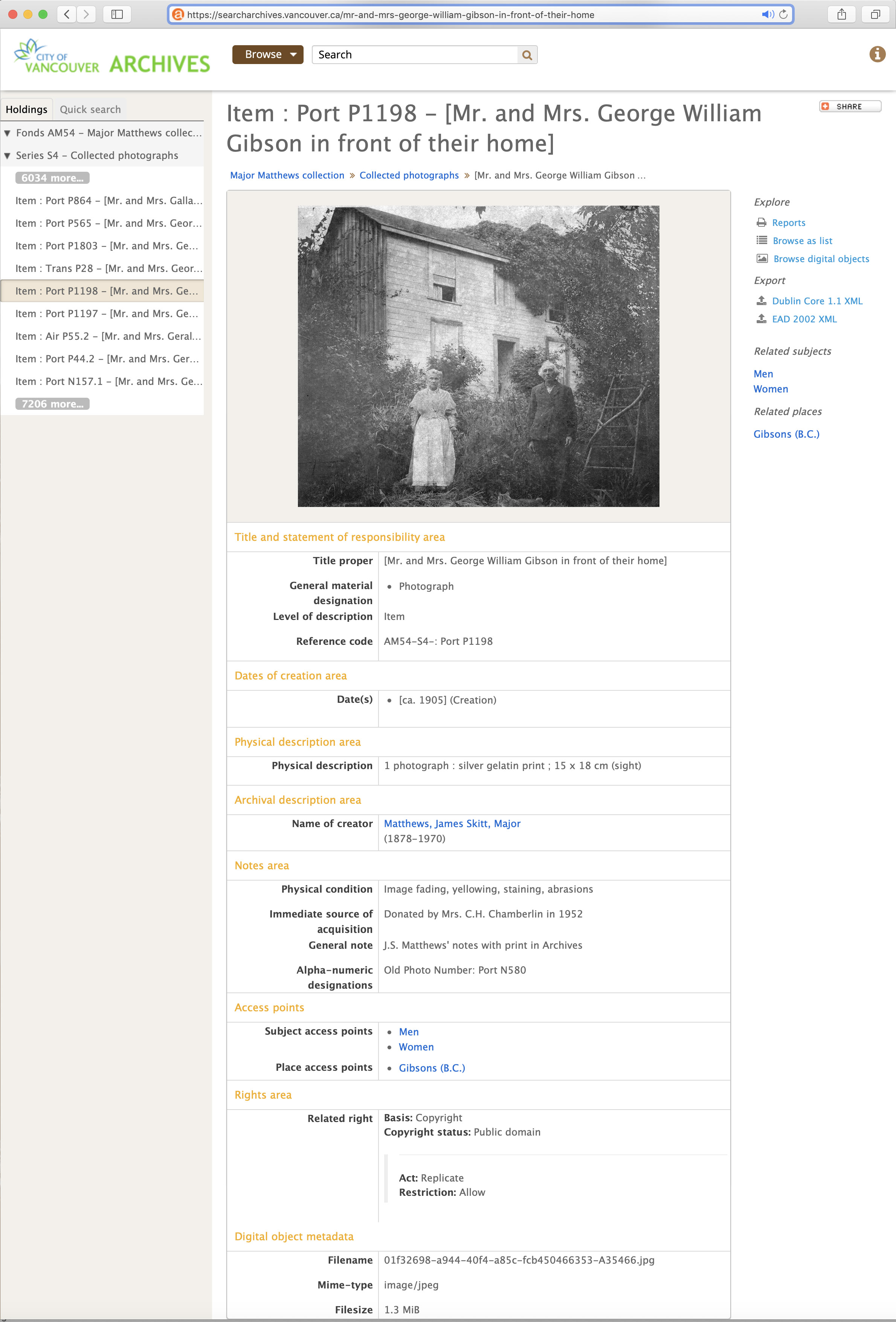
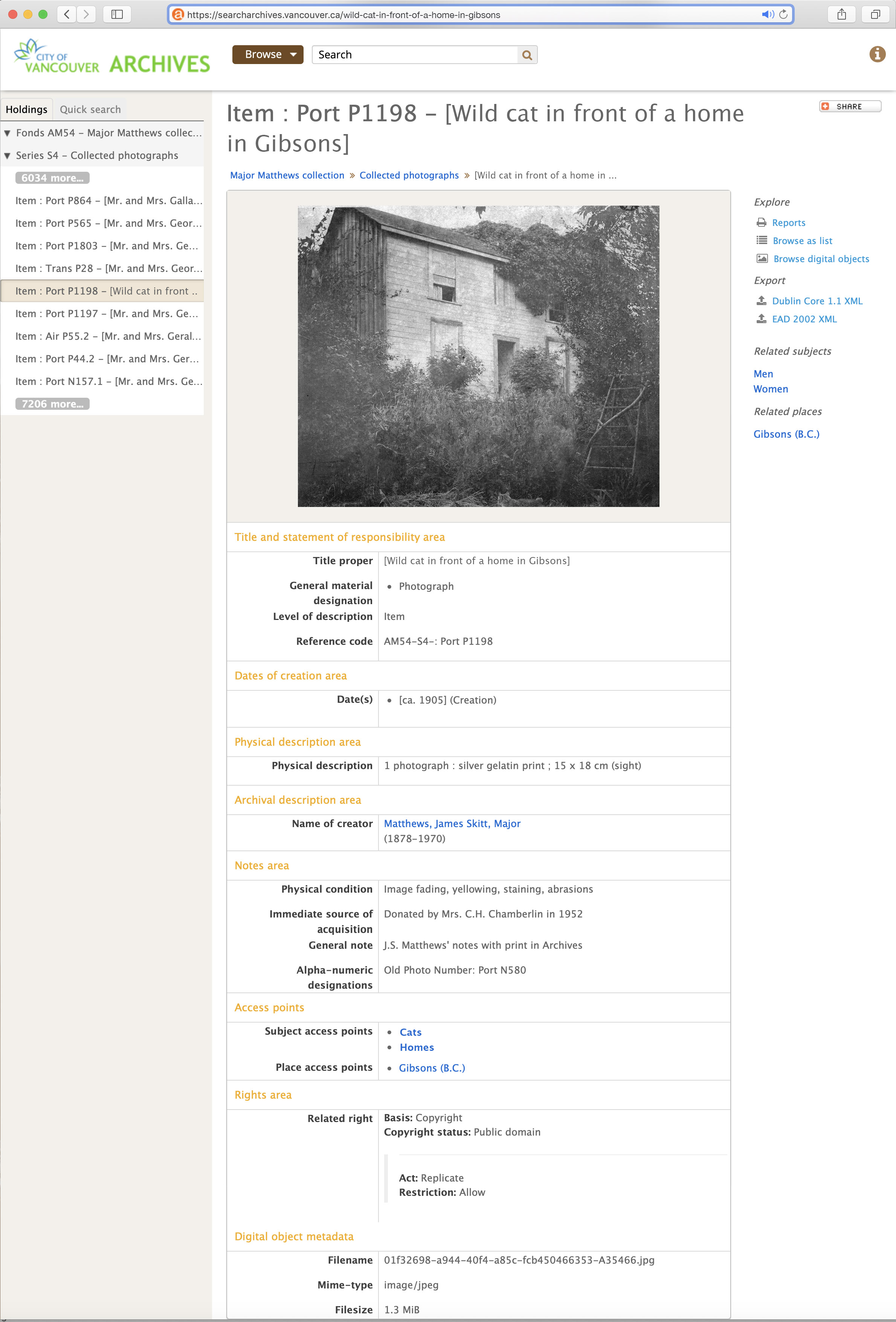
I feel like this is a decent beginning, such a gesture constructive to the decolonizing discourse. I would be curious to discuss this on-its-way-to-being-decolonized image with someone from the Sḵwx̱wú7mesh. I will reach out and see where this might take me.
Is it good enough to remove the colonialists? Should evidence of their decidedly foreign ways of life, their foreign technology - the ladder, the scythe and the house itself - also be extricated?
I think maybe I will do a second stage revision, where the tools and their house are in ruins, as if the homestead has been abandoned.
Guest Post by Jim Fleming
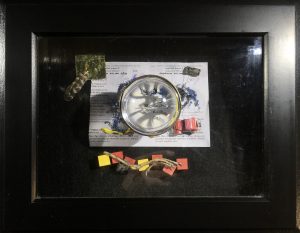
A Perspective on the Cabinet of (in)Curiosities, by Jim Fleming
Introduction
I have always been partial to a cryptic crossword clue. The sleuth in me attracted to the fact that the answer is contained within the clue. You need no more information. So I decided to use this approach to Matthew Talbot-Kelly’s latest work Doctor Kali Gehry’s Cabinet of (in) Curiosities & Ecstatic Nonsense - a dream theatre display spectacle of chimera, folly and tears, (2020). A title replete with diverse references from German Expressionism, Deconstructive Architecture, Peep-Boxes, Cabinets of Curiosities, Kali, Chimera, the meaning of Ecstasy, Nonsense and Folly. All of which I will attempt to make some sense.
A quick description of the piece/installation is what might be described as a maze-like architecture, which contains a series of Peep-Boxes and Cabinets of Curiosities. These in turn house an inventory of objects, created by Talbot-Kelly from fragments he has encountered in the world. The whole is reminiscent of circus and carnival sideshows from the 19th century.
Incidentally, the origins of the word clue/clew is a ball of thread or yarn used to help one out of a maze or labyrinth. One piece within his Cabinet, “Conversations with Gravity” (2020) which Talbot-Kelly describes as “an entanglement of ancestral wools” contained within a bell jar, no doubt alludes to this origin.
Time to delve further into these clues that Talbot-Kelly has created, ball of yarn in hand, and see if I can decode some of their meaning.
Cabinets / Peep Boxes
In the 15th and 16th centuries we see the appearance of Cabinets of Curiosities. These were privately-owned European collections of extraordinary objects, deployed as a means of representing the world. It could refer to the physical cabinet or apparatus which housed a given collection, to the room or series of rooms in which the collection was housed and displayed, or to the collection itself. Collectors were predominately drawn from the upper echelons of society.
Objects included belonged to natural history, geology, ethnography, archaeology, religious or historical relics - sometimes manipulated or faked - as well as works of art and antiquities. They are repositories of the extraordinary, instruments of understanding, with a particular predilection for the exotic, rare, strange or ingenious object. Collectors constructed meaning through their choice of objects displayed and so build their own idiosyncratic version of reality. These Cabinets were originally rooms that contained the whims and interests of their owner. Any collection was the expression of the collector’s taste and personality, in the fullest sense a manifestation of his mind. These objects became ‘semiophores’, that is, they are no longer serving any practical purpose, but rather function as intermediaries between the visible world and the invisible world of meaning beyond. Thus these semiophores predate the Duchampian notion of ready-mades or found objects.
We can see such an idiosyncratic version of this reality, not only in this Cabinet new work, but in Talbot-Kelly’s earliest film, Blind Man’s Eye (2007), where a blind man conjures up past worlds, in his minds eye. These worlds may be constructed from his earthly belongings or maybe they are future worlds of found objects, yet to be found.
In Samuel Quiccheberg’s Inscriptiones, (The First Treatise on Museums, 1565) in highlighting the value of cabinets of curiosities, he demonstrated how organizing objects made their knowledge more accessible; how objects, when juxtaposed or grouped, could tell a story; and how such strategies could enhance the value of any single object.
These historical cabinets are often described as the ‘precursors’ to the contemporary museum which once sought to distance itself both physically and intellectually from the early modern collection. It is interesting that Talbot-Kelly chooses not to ‘exhibit’ in a gallery or museum setting but instead amongst the hoi polloi. Talbot-Kelly’s ‘traveling show’ is closer to the Fluxus vision of art without a home. As George Maciunas, who coined the name Fluxus explained, “The people in Fluxus had understood, as Brecht explained, that 'concert halls, theaters, and art galleries' were 'mummifying'." Instead, these artists found themselves "preferring streets, homes, and railway stations.” To which we can add shopping malls or empty stores.
Talbot-Kelly is then like an incarnation of a Carny, a P.T. Barnum - breezing into town with his wonder rooms and vaudeville show and is then gone. His “in Kamera/’After the gold rush’ (a Venetian retirement station of a fictitious New York cabbie)”, interactive installation, (2015) is a perfect example. The project, a single seat interactive magic box assembled from local found materials, was installed and uninstalled over eighteen hours – open to the public for only six hours. Like a mandala, or Ozymandias - nothing beside remains.
An oddity amongst the cabinet curiosities of old was the Bezoar – an intestinal mass of indigestible material – which had value because it was believed to be an antidote against poison.
So Talbot-Kelly as artist healer? or snake oil hustler?
The Cabinets of Curiosities have obvious connections to Peep Boxes even though they come from different histories and the latter may predate the cabinets. A peep box, raree show or peep show, as they were variously known, was an exhibition of pictures or objects (or a combination of both), viewed through a small hole or magnifying glass. In 17th and 18th century Europe, it was a popular form of entertainment provided by itinerant showmen. A poor/ordinary man’s cabinet of curiosities? This is evident in Talbot-Kelly’s Still Ready, 2020, where the spectator views a scene through a magnifying glass that covers a small porthole into this interior world.
The earliest known peep box have been attributed to Leon Battista Alberti. Primarily known as an architect, he revolutionized the history of art with his theories of perspective in On Painting (1435). Alberti introduced the idea of a "window on the world”. According to his On Painting treatise, the initial gesture of the painter should be to delineate this window and compose its contents within the frame.
When choosing one perspective, one inevitably excludes others. In his Cabinet work, Talbot-Kelly is prescribing the point of view, directing the action of what is revealed to us on this fragmented stage. In presenting a sequence of mise-en-scènes, as in film, he is shaping a narrative that both, supports and contradicts the narrative within the frame and within the larger Cabinet. He shows the non-theistic viewpointfor what it largely is: banal distracting nonsense. Then again, if we are present, and still, maybe there are mysteries to be revealed.
Some artists from 17th-century Holland, like Samuel Dirksz van Hoogstraten created a type of peep show with an illusion of depth perception by manipulating the perspective of the view seen inside, usually the interior of a room. These peep boxes drew upon perspectival geometry (no doubt aided by Alberti’s theories) and the new science of optics in order to entice their viewers to explore imaginary spaces in a novel way.
The peep box was ‘a construction that also offered various views adding up to make a single world. No single view dominates in the interest of this additive way of piecing together the world’. Hoogstraten’s peep box thus enabled the artist to create the illusion, not only of many worlds contained within a single box, but of multiple worlds seen from two distinct vantage points. Along with multiple and varied framings, these multiple viewpoints and multiple worlds are front and centre in Talbot-Kelly’s work. Each exhibit moment in the cabinet is carefully prescribed, carefully composed within a frame. Further, many times we are viewing these staged moments through glass, glasses, loop magnifiers, screens and other optical instruments. At other times, as with Digital Aquarium 2020 where, through various portholes, we are shown on various monitors and screens, different viewpoints and perspectives of a single object. We have to assemble in our minds eye what we think we have seen.
German Expressionism / Gehry / Deconstructivism
The Cabinet of Dr. Caligari (1920) is a film about an insane hypnotist who uses a somnambulist to commit murders. The film takes place in Holstenwall, a shadowy village of twisted buildings and spiraling streets. A mysterious man named Dr. Caligari, a sideshow operator, seeks to present a spectacle at the fair, which features a somnambulist named Cesare. The majority of the film's story and scenes are memories recalled by an insane narrator, and as a result the distorted visual style is his view of the world. The ‘twist’ at the end is you realise that the story has been told from the perspective of an insane narrator, and therefore you cannot accept anything you have seen as reliable.
In addition to the title, it is clear that Talbot-Kelly’s reference here is the films use of jarring perspectives, sharp-pointed forms, structures and landscapes that lean and twist in unusual angles, an almost cubist, deconstructed perspective. Implicitly, Talbot-Kelly is presenting himself as an unreliable mise-en-scène-ist, a trickster architect. As well, his Cabinet shares with the film an understanding of narrative logic as being largely contingent.
Talbot-Kelly’s twist on Caligari as “Kali-Gehry” are references to a Hindu goddess and the Canadian architect Frank Gehry.
Kali, the Hindu goddess, is usually depicted with blue skin, at least two sets of arms and sticking her tongue out in defiance. She is seen as the goddess of Time, Creation and Destruction. She is the one that bestows moksha, a Hindu concept for emancipation and enlightenment, especially from samsara, the cycle of death and rebirth. The fact that Talbot-Kelly should choose this goddess and her associations are clear indicators that this is how he views his ‘found objects’ and how they are ‘reborn’ into his worlds as something different from their original incarnations. She would also have featured well in a 19th century sideshow some of which featured people with multiple limbs. As well as this cabinets “Inevitable, Kali’s View” (2020), this reference to Kali may also be from Talbot-Kelly’s itinerant travels to Pondicherry, India. Here he produced “falling: catching”, installation, (2014). Bricks and jute-tied scaffolding are arranged as a wall that is seemingly both in the process of tipping over and being ‘caught’. “falling: catching” is a semi-improvised architectural installation that uses some of the most ubiquitous of Indian construction materials to create a ‘frozen moment in time’.
Dr. Caligari may be some sort of alter-ego for Talbot-Kelly himself or the titular character from his own film The Trembling Veil of Bones (2010). There maybe also be a reference to the sleepwalker, someone who can seemingly go about their normal life, albeit limited, while sleeping. To whom might Talbot-Kelly be referring to here in this era of ‘woke’?
When he was young, architect Frank Gehry built miniature cities out of ‘found’ scraps of wood from his grandfather’s hardware store. This sense of play may have inspired him later in his career to use corrugated steel, chain-link fencing, unpainted plywood and other utilitarian or "everyday" materials. Gehry's pre-Guggenheim style at times seems unfinished or even crude, but his work is consistent with those artists who used ‘found objects’ and non-traditional media to make art. Further, like Talbot-Kelly’s work, Gehry’s buildings are essentially non-perspectival, in that they are multifaceted unfoldings of space and its delineation.
The Pritzker Architecture Prize jury, when describing Gehrys work, might well have been describing the work of Talbot-Kelly. “His buildings (substitute art/films/installations) are juxtaposed collages of spaces and materials that make users appreciative of both the theatre and the back-stage, simultaneously revealed.” A graduate architect, Talbot-Kelly has said “I am engaged in many of the conceptual and physical matters of architecture. My recent projects are becoming more architectural in scale and scope, including this cabinet. I consider this cabinet work as architecture and theatre, and ‘live film', as much as it is art.”
The references to Gehry and in turn to German expressionism are clear in the deconstruction of Talbot-Kelly’s maze-like playful layout . This destabilizing is achieved by juxtapositioning, fragmentation, unpredictability and controlled chaos within the show.
Ready-Mades / Present-at-Hand / Assemblage
Talbot-Kelly’s work contains all the tropes of Neo-Dada with its combination of playfulness, appropriation and iconoclasm, although his ‘found objects’ may have already encountered their destruction, at least from their original use. This is encountered flotsam and jetsam from a deluge, of 20/21st century materialism. Talbot-Kelly has said “The tidal shore, like the local highways, are my art supply store.”
The ‘found objects’, or ready-mades of the Duchampians, are somewhat different to the ‘found objects’ of Talbot-Kelly. The ready-mades of Duchamp resemble what Martin Heidegger called the ‘ready-to-hand’. Heidegger explains, when we see a hammer we understand its function, its essence as an object but when it is broken, is it still a hammer? We then shift our view from defining an object (a hammer) to perceiving it (its constituent parts). Heidegger describes this broken hammer as a present-at-hand. It is not the way things in the world are usually encountered, when a hammer breaks, it loses its usefulness and appears as merely there, present-at-hand. We have all experienced this when we encounter a tool or object whose purpose at first we are unsure. It is just an object devoid of any preconditions.
In much the same way a Talbot-Kelly ‘found object’ starts out as present-at-hand but is transformed, into some new ready-at-hand, through assemblage and collage. An example of this is Vipers Nest (excellent technology), cabinet seven (2020) with it collection of bits of wire and paper twist-ties, or Melancholic Ring Worm, 2020, where a vacuum hose in a jar is reminiscent of something you might have expected to see at a circus sideshow Useless fragments as art object.
Ecstasy / Nonsense
Ecstasy or ekstasis, from Ancient Greek means "to be or stand outside oneself, a removal to elsewhere”. When we view these other worlds of Talbot-Kelly we are invited to ‘stand outside ourselves’ in order to imagine ourselves within these worlds. And what is it we are viewing? Does Talbot-Kelly suggest, nonsense?
Nonsense would suggest a lack of any coherent meaning, sometimes synonymous with absurdity or the ridiculous (Dada). In the philosophy of language and science, nonsense is distinguished from sense or meaningfulness. For Jacques Derrida, there is no such thing as meaning – it always eludes us and therefore anything goes. Other philosophers have called his view ‘nonsense’.
Nonsense is also an important field of study in cryptography regarding separating a signal from noise. So my plan to ‘decode’ Talbot-Kelly’s work by following the clues in its title may only take me so far as it becomes hard to distinguish the signal from the noise. Referencing John Cage’s “I have nothing to say and I am saying it”, Talbot-Kelly has said “I have nothing to reveal and I am revealing it”.
Spectacle / Chimera / Folly
Talbot-Kelly mentions a ‘spectacle of chimera’. Spectacle may be a reference to Guy Debord’s “The Society of the Spectacle” (1967) who’s Situationist movement had its foundations in Dadaism and Surrealism. Debord’s ‘spectacle’ was a critique of advanced capitalism manifested in advertising, television, film and celebrity, where commodities rule the consumers and even our experiences have become commodified. This is evidenced today within our culture of corporate surveillance capitalism. Talbot-Kelly’s ‘found objects’ are then the cast offs and cast asides of this consumerism. His cabinet is to be presented in a mall, as a pop-up store that sells nothing save vaporous chimera, but displays monetarily worthless refuse as being circumstantially, socially, conceptually, historically, anthropologically valuable.
When Talbot-Kelly uses the word ‘chimera’ he may mean in the greek mythology sense of a creature composed of the parts of multiple animals. An example is one of P.T. Barnum’s many hoaxes, the ‘Feejee Mermaid’ - a monkey’s body grafted onto the body of a fish. But there are human chimera also. A fetus that has absorbed its dead twin in the womb is a human chimera, having two sets of DNA. As are people who have had bone marrow transplants. In some cases, all their blood cells will match the DNA of the donor. In the 19th century there was a traveling sideshow that featured an Indian boy, Lalloo, with two sets of limbs said to be a boy and girl mixed together, reminiscent of the goddess Kali. In Talbot-Kelly’s earlier films, Blind Mans Eye, and Bones, there is a character, Heartman, part human, part machine, part avian, that is a chimera. Although a digital/virtual character, you get the sense that he is made up from leftover fragments in Talbot-Kelly’s digital bins. In its broadest definition most of Talbot-Kelly’s ‘curiosities’ are chimeras, being composed of disparate parts, illusory, wildly imaginative and somewhat, implausible.
Talbot-Kelly’s mention of folly may be related to the french word folie and to the nonsense in the title but I think there is definitely a resonance with architectural follies, primarily built as decoration but in appearance suggest some practical form of use. Eighteen century versions were often mock Roman temples, ruined abbeys or Egyptian pyramids but they are also not easily defined. These ‘architects’ were not constrained by form or function but only by their imagination. Ireland, Talbot-Kelly’s birthplace, was once considered to have more follies an acre than anywhere else in the world. This can be explained that during the Irish famines of the 17th and 18th centuries, in order to provide work for the needy and not deprive existing workers, follies were constructed. Some of these, roads in the middle of nowhere that went nowhere and piers in the middle of bogs were like early conceptual, environmental art projects.
While Talbot-Kelly ‘Cabinet’ is not simply a folly it follows some of the the same principles by resisting attempts at definition. Talbot-Kelly may want us to believe or maybe he believes himself that his sideshow is a pointless folly but this is not the case. This unwillingness to be defined is what marks Talbot-Kelly’s work as essential.
Theatre of Dreams
I have left until last the most understandable phrase of Talbot-Kelly’s work title but I believe it encapsulates the whole of the work because first and foremost this piece can be seen as theatre.
There is a line to follow from Talbot-Kelly’s work from Alfred Jarry’s ‘pataphysics’ and Antonin Artaud’s ‘Theatre of Cruelty’ and through to the 'Theatre of the Absurd’ which all deal with absurdist characters who are in crisis because their world is incomprehensible. They are trapped by some ominous force that they can not understand. Their world defies science and logic. Talbot-Kelly’s film characters can be seen in this Beckettian light. The chaotic world outside of ‘Bones’ clockmakers shop in ‘The Trembling Veil of Bones’ or the internal anarchic world of the old man in ‘Blind Man’s Eye’. Artaud spoke of ‘anarchic dissociation’ and ‘profound anarchy’ as two of his key principles in his new form of theatre. These ideas spoke to the practices of composer John Cage who heavily influenced Fluxus. He understood an artwork as a site of interaction between artist and audience. He privileged the process of creating over the finished product. This is evident in earlier work by Talbot-Kelly’s where he held ‘closings’ of his installations and encouraged dialogue on his work as it was being created in situ.
Artaud described his ‘Theatre of Cruelty’ as a "communion between actor and audience in a magic exorcism; gestures, sounds, unusual scenery, and lighting combine to form a language, superior to words, that can be used to subvert thought and logic and to shock the spectator into seeing the baseness of his world." Talbot-Kelly’s attention to mise-en-scène is a clear indication that he also considers his work theatre along these Artuadian lines. He views the contents of his cabinets as, elevated refuse, provoking us to confront our materialism.
There are also parallels with Bertolt Brecht’s ‘estrangement effect’, where the spectator is confronted with subjects they would be used to seeing in other surroundings, which is furthermore connected to Freud’s concept of the ‘uncanny’, where something is both familiar and strange at the same time. This, I believe, can be expanded to include the objects in Talbot-Kelly’s ‘Cabinet’. We recognise Talbot-Kelly’s ‘found objects’ as familiar but then they are assembled into something strange yet familiar. His sideshow and objects therein may look familiar but you would not expect to see them arranged in such a jarring and theatrical manner let alone as a store in a shopping mall.
In one of his manifestos 'Theatre and the Plague', Artaud later declared that his theatre is designed to be a place of ritual, ceremony and healing; both church and hospital. A place where an audience could both contract the ‘plague’ and be cured of it. Talbot-Kelly’s Red Balloon, 2020, an inflated blue surgical glove found in our current Covid-19 era, is presented to us on a plinth as something to be revered. Quite timely in this era of pandemic and plinths and recalls the earlier question of Talbot-Kelly as possible healer, through laughter from the ridiculous if not literal medicine.
Artaud saw his contemporary theater as decadent because it had “lost the feeling on the one hand for seriousness and on the other for laughter”. And there is humor throughout Talbot-Kelly’s work. He presents us with objects with titles like Inevitable, Kali’s View, and then lists it as being made from ‘alphanumerically embossed metal plate, rusted blue pipe, sliced dollars, nickel shavings, quad armed helping hands, pince nez glasses’. The result hints at the common phenomena Pareidolia, that is to anthropomorphize, to see human faces in everyday objects. Or in Vipers Nest, mentioned earlier, ironically made from the not so dangerous materials of paper, plastic and wire ties or (deep fake) Seven Dwarfs, 2020, made from a flattened egg carton and seven seemingly random fragments.
This dichotomy of seriousness and humour is evident in the ‘pataphysical’ work of Alfred Jarry, a precursor of the Dadaist movement, Artaud and the ‘Theatre of the Absurd’, who described ‘papaphysics’ as ‘the science of imaginary solutions’. Others have described it as a “absurdist pseudo-philosophy/ideology” or a “form of conceptual flatulent hot air that hinges on the idea of utter nonsense”, with which I think Jarry would be very happy. It also resonates with Talbot-Kelly’s “I have nothing to reveal and I am revealing it”, which is both a meaningful phrase and nonsense.
Artaud attempted to create a non-written play with a new kind of language; a physical, visual and pictorial language. Regarding Freud’s Interpretation of Dreams, Artaud stresses another important element towards this new visual and language. This does not mean that the theatre of cruelty is a theatre of the unconscious; it means that in dreams, speech is transformed into images. It should be a theatre of dreams.
Conclusion
If the curiosity cabinet existed to demystify the world, contemporary art often seeks to problematise it, to obscure it, to re-mystify it. But an artist is also someone who is capable of unveiling the invisible.
Talbot-Kelly collects objects to resurrect them as new curiosities only at a later stage (when the sideshow have moved to its next venue) to leave them behind at the dump to reclaim their non-status. Talbot-Kelly’s work is like a modern day ‘vanitas’, a symbolic work of art showing the transience of life, the futility of pleasure, and the certainty of death.
His work also functions as a time machine, recalling past cultural practices hidden beneath layer after layer of referentiality. This referentiality, as I have tried to allude to, is sufficiently entangled, however, that the practices of one era merge seamlessly with those of another in a complex web of associations which eschew neat compartmentalisation or categorisation.
But Talbot-Kelly’s work is not merely an echo of past practice, but rather the continuation and transformation of a cultural performance which may be considered to parallel those of the early modern collector. Both creator and collector, Talbot-Kelly is like some kind of time traveller as his ‘contemporary’ artwork has resonance across multiple temporalities, offering us a glimpse into the past - a pastiche - of whispering ancestors and also a glimpse into his own past of art making, film making and architecting.
So is Talbot-Kelly like some Marquis of old, master of the house? Or some itinerant shaman, traveling conjurer, who, having mastered artifice and illusion, is out to fool the world? or heal it?Talbot-Kelly has said ‘I am the director of this bonkers theatre of the absurd, and you the viewer, become a player on the stage, and therefore complicit in its absurd intentions”. P.T. Barnum often quoted the lines from Hudibras, by Samuel Butler, “Doubtless the pleasure is as great, Of being cheated as to cheat;” It seems like it takes two to tango.
about Bones
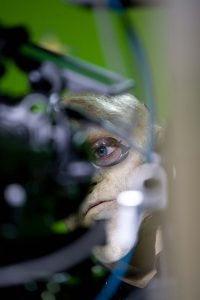
I remember the horses... galloping... No, mostly walking and standing about. Contained... or wait... maybe that's not...
Blind man is who I want to become and Bones is who I am afraid of becoming.
Bones is about a puppet - who is stuck in time. The mental or psychic or perceived time vs the external and public and real time.
The graphic novel
In which for the first time ever, we get inside the spiralling head of the uncompromising figure known as “Bones". Not! instead we see the physical journey - his history unfolded from here to there, yet seemingly being of little influence on the development of his person.
It follows parallel alternate futures of the same character - Bones and blind man. Exploring the ongoing adventures of them both. Of course, BM doesn't leave the riverside on his adventures - his journeys are imaginative, and display his presence. In contrast, Bones moves all over the place, reacting to this situation and that, buoyed as on a sea, but not really going anywhere. Bones studio is over the bridge, on the far side from BMs bench.
At times, it's a bit like Rosencrantz and Guildenstern are dead - we follow the minor characters, and sometimes they cross paths w Bones n BM.
Episode 1 - wherein we meet Bones, doing his (no)thing, in his studio. We circle around from outside the studio, spiraling closer and closer to Bones face, which we double up w the blind man's.
Episode 2 - wherein nothing happens w Bones, but we notice other activities n goings on. He's curious about the crows.
Episode 3 - wherein we first meet the postal robot doing his deliveries. We start to follow him cantering to his next delivery...
Episode 4 - wherein we continue to follow the postbot but from underground POV's. Revealed to be heartman.
Episode 5 - Wherein we follow the blind man to his bench from crow's POV.
Episode 6 - Wherein the giant Robot funeral passes Bones' studio and the bridge above blind man.
Episode 7 - in which we explain Bones baldness. Hit on the head - suspicion is that he's not all there....
Dad's death
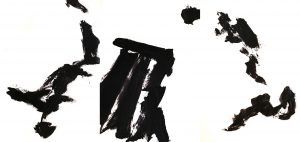
Dad's death
My Dad was a poet all his life. In many ways words were his refuge. I remember feeling after dad died, wait, that’s it? Is that all there is to a life? These few books, records, furniture, clothes and a whole whack of words.
I've looked for signs in Dad's pile of words. A search for a meaning of some kind. Poetry? Life’s lessons? Nonsense? I've concluded there is mostly the latter...
Reflecting on what I am doing: I don’t really know what I am doing, yet I am doing it anyway.
I suppose, I’m gathering evidence of being alive.
I inherited from my dad a certain restlessness. Some might say curiosity. Or impatience. More than not, I feel I have tempered this potential negative impulse to work for me.
I want to make my mark, draw my lines, build my fort.
At the same time, I endeavour to remain hungry, nimble, always looking, searching. To remain open to possibilities. As well as be distracted by all the stupid things invented by white people to try and deal with the dread of life.
The weight of gravity
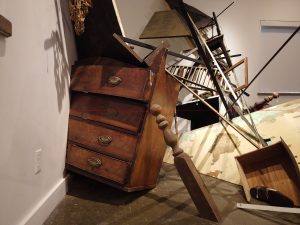
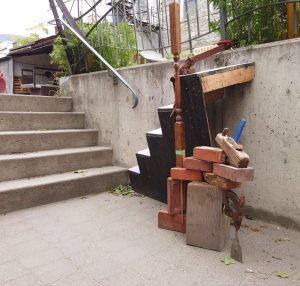
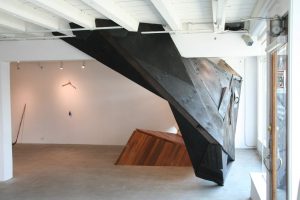
I am curious about the effects of gravity.
At its most elemental, getting up in the morning - indeed being alive, like architecture, is about resisting gravity.
Walls, fences, sand castles, the human body, each becomes more ineffectual and less efficient as they move further from their typical vertical orientation. When compromised by gravity, they need to be propped up, provided with a crutch. Crossing this tipping point from resistance to gravity, they become doubly useless, their essence not only compromised but they become in the way....
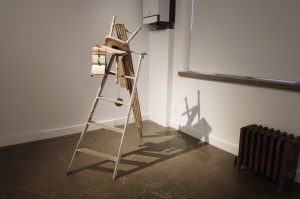
Museum 3.0 Exhibition Ideas
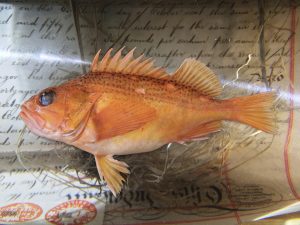
Some brief "Museum 3.0" exhibition ideas
These ideas start with the primary exhibition space of the host museum/gallery being reconsidered as a completely mutable (and empty?) space.
- The visitors enter an essentially empty space. Arranged at the entryway, are various objects from the collection, along with various podiums, plinths, lights, and a drum with mixed up index cards inside. The visitors are invited to choose and arrange the artifacts in the space as they like. Attendants are there to support the visitors decisions. A randomly drawn index card, with already printed poetic descriptors of origin and purpose can be drawn, or written on provided blank cards.
- Don’t touch the museum walls! Instead, mark and affect a pre-assembled new skin. These new exhibition surfaces stand in defiance of the institution. The visitors are welcome to mark up the walls and floor of this new skin - get dirty with your hands and feet. Means to make graffiti, stencils, splashes, pen, scratches, holes etc. are provided. Mark the walls, mark the floor.
- A reverse artifact library. The visitor enters into a space where various artifacts have been brought out and arranged in shelves, behind desks with attendants. The visitor can register their personal details with the attendant, select and sign out an artifact. They are encouraged to take it home, "show it around" and document the artifacts holiday from the institution.
- Create a directional exhibition, looking through a perspectival proscenium. Looking one way, the exhibit aligns into something pleasing and stable. After walking through and turning around, you see the underlying discomforting truth and instability.
- Create an exhibition that is designed as a labyrinth or puzzle. By successfully navigating through one level/area, the next level/area is revealed.
- Have an exhibition that is a combination of old stuff from the collection and contemporary possibly found things, brought by visitors
- “Once of interest” - is an exhibition of all the unclaimed, un-patriated contents piled into the centre of the main space... It becomes all about, in-the-moment mise en scene & mise en place.
- Decolonizing the photos - plain and simple, photos are lies. this exhibition aims to un-lie them. Take classic colonialist archival photos and remove the colonialists and evidence of their existence. Exhibit the cleaned photos side by side with their original, but without any English explicatory text. Instead, only text and audio that is presented is from the local indigenous peoples.
- Decolonizing the architecture. Empty the rooms and dismantle the walls. Replace them with screens, glass, or nothing, leaving rooms open to the outside. Invite local indigenous peoples to enter and orchestrate events as they like.
- Have an audio only exhibition a la dada exhibition at the Pompidou - but using local dialect.
- Create a new delicate filigree shell in an otherwise empty central space. This becomes the place to invoke the muses.
- invite guest curators to comb through the permanent collection. allow them to do mise en place, as well as the events around.
- Visitors are invited to select individual artifacts and have a moment with them in the space. A place of individual reflection.
House Reimagined
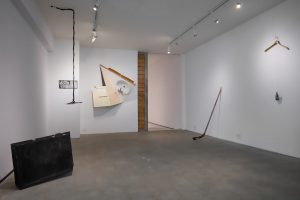
"The (n)Atrocity Exhibition – a house crash for the rest of us" was an artist residency and exhibition at Vancouver's BAF (Burrard Arts Foundation) gallery.
A house is of a scale and materiality that is essential, relatable, familiar. In working with such scaled and sourced materials, there is already something for most viewers or participants to relate to. Providing an elemental way into my work, without explicit prescription, is important to me as I am more inclined to abstraction and less inclined to realism.
Space itself is ephemeral, intangible, defined by its containing surfaces. Albeit with good reasons - like cost, efficiencies, gravity - these defining surfaces being flat and straight and joining at 90 degree angles are never-the-less conventions. In this BAF work, like other works mentioned above, I am “playing with” space. In the placement of the work in the larger gallery space, the form that the work takes and the AR extensions, this work is intended to be spatially provocative.
Another thing about the notion of home is that this is the traditional site of the threshold between public and private space. The house facade - or face - separates interiority from exteriority. A prominent theme of this BAF work is the re-regarding of this liminal skin, which, in 2017, is no longer the explicit privacy threshold it once was.
Have a look at the street view of The (n)Atrocity Exhibition here
Museums - Outmoded Embedded Ideologies
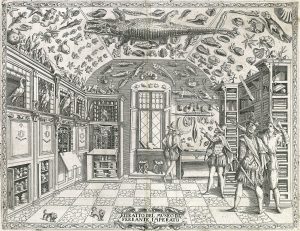
Towards Museum 3.0 - One persons junk is another persons weapon – towards a manifesto that existentially blows up museums and galleries to calibrate for an emerging present.
Museum's Outmoded Embedded Ideologies
Is it possible to reform the foundational paradigm and present reality of a museum? Does the weight of history, the weight of their history, make them largely immovable, unresponsive to our twenty-first century society and culture?
There is a lot of merit in tearing up/down much of the museum institution. As a culture, as a society, we should admit that the foundational tropes of museology are no longer relevant. If these tropes aren’t dead, they should be killed off. Start again. Start over. Rather than trim around the edges, we need remove their outmoded embedded ideologies. Rather than partial insubstantial reframing, museums need to have their architectural, exhibition and cultural agendas substantively upended.
I think we need reprioritize the museum’s mandate to be about asking difficult questions rather than supplying inadequate answers. It should be less about making the visitor feel good, coherent, edified, and become more about about making one feel provoked, uncomfortable, questioning.
A museum is an instrument of perception, if not a tool of outright propaganda. In the overwhelming number of cases around the world, museums are tools of propaganda justifying a colonialist past, extolling the virtues of the oppressing “victor”, at the expense of the subjugated oppressed. Implicitly, museums subscribe to the idea that they can somehow arrive at an evidentially based, coherent, and legitimate narrative on a specific event or time frame. That, in effect, one can freeze time, and with an authoritative voice, let people know what happened in that moment.
Let's recognize the implicit twin lies of objectivity and the lie of progress. Let's recognize too, the power of language. Individual words like “holdings” vs “collections” and stealing vs acquiring vs borrowing. As well as the authoritative power of a narrative.
Rewriting museum's mandates and programming language using more inclusive politically correct language is not good enough. Pledging to be more representative in the collections isn’t good enough. Having token exhibits from a contrarian perspective isn’t good enough. Even in the cases where indigenous peoples have made their own museums, they are are still engaging in the terms of the oppressor. These treasures hoards, oftentimes ill-gotten are essentially "winners" spoils, linearly sequenced, elegantly and definitively framed, housed in a typically stodgy edifice, all arranged to justify the expansionist aggression of the patrician founders. The purpose built edifice is virtually impossible to challenge by even the most progressive and well meaning exhibition, as fundamentally, the exhibit must conform to the institutional norms, and the edifice remains.
Extolling the virtues of the colonizers is wrong, even reprehensible. And it is also small minded. For many of us, the most interesting parts of the renowned Capital museums are the non western, non euro centric cultures represented. Yet, do any of these depictions belong anywhere near a museum, the embodiment of a European victory march? In contrast, extolling the virtues of the colonizers - seems ridiculously small minded, as museums remain locked up treasure troves of ill-gotten goods.
Artifacts do not retain their validity taken from their legitimate contexts. Most - if not all? - museums are operating from false premises: that there is a sanctified historical meaning or legitimacy that will be gleaned by regarding objects taken out of their legitimizing contexts, and that this meaning can be retained or re-assigned or re-imbued into artifacts by means of presenting them in some sort of sequential narrative. Not only are such narratives always incomplete, for the overwhelming majority of indigenous cultures, the very idea of linear time is anathema to their traditional worldview.
How to “value”? Is it possible for something to retain value, when it is removed from the context in which it accrued its value in the first place? Meaning is not magically retained by the naming of things, or the ordering of things, or the containment of things within a certain frame. Objects don’t have talismanic powers in and of themselves. They need be imbued with these powers over time, and honoured by the shared values of their society. The relative talismanic powers of the indigenous people’s artifacts, have not only been been killed of their former power, but they have accrued the static, immovable, constipated power of the colonialist enterprise.
The ends do not justify the means. Also implicit in museums are the embodiment of the sentiment - in this context quite horrifying - that the ends justify the means. They don’t! One problem lies in the premise of their origin as cabinets of curiosities, “victory cabinets”, family heirlooms, and spoils of colonization. The colonizers/winners task was fundamentally dishonest because they knowingly claimed land, at the end of a gun, that they knew was not theirs. Soon after arriving they learned that the colonized people had completely different premises of ownership, sense of time, sense of value, which they knowingly, dishonestly, took advantage of. Even the trading or buying of artifacts inevitably came about by completely unbalanced "agreements". I’m thinking of missionaries knowingly trading and "gifting" pox infected blankets, as well as the desperate starving artist. Such fundamentally unbalanced "agreements" continued by the be-quested foundational collections of most major museums. And it was not just the indigenous that were fleeced, other marginalized and oppressed peoples were as well - people of colour, poor people, people from minority religions or subordinate cultures, and starving artists. More often than not, the museum's collection were started around some pious wealthy merchant or cleric who on their deathbed, after living a life of selfish hoarding, suddenly decided they were concerned for the well being - “the education” - of others.
We must undermine the one-sided cultural and historical narrative . Accept that the conventional associated narratives around the collections are incomplete, too limited in scope. Really, they are no more legitimate than a contemporary fictional one. I believe it is our duty as cultural workers, if not every single person in the so-called first world - me as an artist and exhibition designer, you as a curator, you as a cultural official - to continually and actively undermine the one-sided culture and history.
Willful naivety - I often speak of willful naivety as being a starting point for creation in a world where everything has been done. In an expansive and open minded way, let's ask what else could a museum be? This is the seat of the “will” I am talking about in willful naivety.
Make museums predicated on asking questions. Museums are predicated on the collections and their efficacy in answering a narrative. Lets switch it around, make museums predicated on asking questions. Allow them to express doubt, be non conclusive, be difficult. Even make us feel uncomfortable.
Remain in the not knowing. Museum managers and administrators should transition to being about facilitating and holding contradiction and holding questions alive rather than providing definitive answers. Remain in the not knowing. We need to stop spoon feeding our audience. Lets make room and allow speculation, activation by the visitors imaginations. Lets allow some materials to remain secret, mysterious, un-illuminated, only partially revealed and concealed.
The entire museum edifice needs to come down. The issues facing museums are not simply issues about phrasing. The artifacts need be decolonized, the photos need be decolonized, the organizational structure of them needs to be decolonized, and the very architecture needs be decolonized. But decolonizing isn’t enough. Answering how to decolonize the built architecture is especially daunting. One would imagine, emptying is a start. Most indigenous groups don’t look at the world through a euro-centric’s eyes. At the risk of stereotyping, indigenous peoples views are most often oral, temporally dynamic, less static.
We should empty them! Society and museum custodians should abandon the idea of permanent collections. It’s an attempt to freeze time, itself problematic. Dismantle the centralized architectures. Divide up the resources into smaller units. Bring the stuff back to the people. Even in small town museums, the priority should be returning the artifacts to the donors family or the victims. The rest can be auctioned. If they are not returned, sold or collected within a certain timeframe, either bring them to the dump, recycling depots or destroy them.
Deploy a new language of organizing principles. Out with the inappropriate language of order, sequence, balance, logic, rationality, perfection, symmetry, truth, definitions, answers, etc. Let's deploy in its place the language of contradiction, collage, montage, juxtaposition, incompleteness, nonsense, confusion, fiction, mystery, questions.
Reframe as seats of the muses. At the root of the word museum, is the concept of a “seat of the muses”, meant to amuse, and invoke inspiration. Leave the central space of the museum be empty. Hollow out the present central spaces. (Like LAs old Temporary Contemporary, by Frank Gehry.) It becomes potent - full of potential - by the absence of signs and objects. It becomes a space for contemplation. To ruminate, to reflect.
Inconvenience as the modus operandi. Let's have exhibitions be inconvenient - the height too low, the floors crooked, the walls sticky or covered in soot, badly signed, with poor lighting, slightly hidden. Of course, provoking such unease might be resisted by bylaw officers and insurers. (But let's be honest, people skydive and party on the water in the age of Covid19.)
New tech doesn’t solve or mask anything. Assigning technological solutions to the age old problems of musology does not validate these museums outdated modes. Oftentimes the technology itself - the medium itself - gets in the way of any alternate message.
Stop making group experiences and start making singular experiences. One person at a time. The typical museum perspective is aspiring to be too broad reaching, too consensual. Instead make the experiences singular, specific, reaching one person at a time. Yes I mean literally the “perspective”.
Ol' Dear
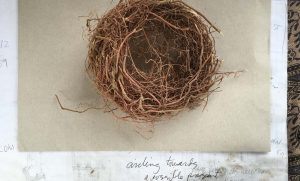
Ol’ Dear is a new kind of super hero - mad, blind, and pissed off.
Waaaaay back in 2006 - long before Scorsese's Irishman - I made a proposal to the Irish Film Board for a short film about Old Timer Gangstas.
Ol’ Dear is set in Dublin in the immediate future, year 2013. Gasoline prices have made automobiles almost nonexistent, wind turbines are ubiquitous, supplies rationed, huge piles of garbage ring the city’s periphery, everybody is continuously plugged in, service from the service industry is non-existent, and stereotypical giant holographic billboards grace the sides of buildings. Ol’ Dear, our eponymous disenfranchised and anachronistic heroine and her posse of equally marginalized cronies are out of patience. With nothing to lose at this stage in their lives, ‘they take up arms against the oppressor’ and become ‘freedom fighters’, leading the self-styled Hand Bag Revolution.
~
Overwhelmed by the forces of the status quo, at the age of 87, Agnes O’Connor, a mild mannered retired hairdressers bookkeeper, grandmother of eleven and soon to be great-grandmother, decides to take radical action - she became, at least in her own mind, a freedom fighter.
Agnes is rebellious because she is tired;
tired of not being seen as an active contributer to society,tired of being taken for granted,
tired of nobody listening,
tired of her old age pension barely covering her subsistence,tired of the pollution and desecration of the forests and wa- ters of the world,
tired of imagining the suppurating world her grandchild will grow up in,
tired of ineffective public transportation,
tired of the rich getting richer while the poor grow ever poorer and exponentially in number,
and tired of a few bossy nations telling us what to eat and see and believe.
Against conventional logic, Agnes is taking action.
~
Some Questions
I have often wondered when confronted by unyielding indifferent and at times brutal might, what of non-violence? What would Gandhi do today? Many would say that non-violence is the better and more noble way, to say nothing of being politically correct, but does non-violence change any- thing? Is it not true, that the dominant and unyielding powers that be, these ‘violators’, only understand violence? Is violence an appropriate response to volatile and life oppressing circumstances, real or imagined? Do the means get justified by the ends?
The starting premise for the film is what if the ‘ordinary’ people of Nelson Mandela’s and Jimmy Carter’s generation decided they had enough, what sort of action would they take? and would they have to be mad (or desper- ate?) to try and resist the seemingly unstoppable global forces at this stage of their lives? and if they do take action like I am suggesting, are they ‘freedom fighters’? ‘terrorists’? or merely loonies? and perhaps most interestingly, how much sense would drastic action initiated by their generations hand make to larger society?
If Agnes O’Connor - mild mannered and retired hair- dresser’s bookkeeper - is ready to take action, in- cluding condoning and us- ing violence, then what hope have we?
Museum 3.0
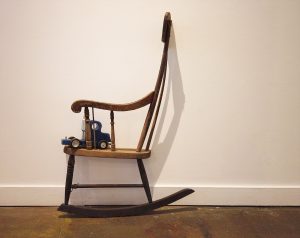
Museum 3.0
This is the first in a series of posts I'm going to make on what I am calling Museum 3.0. Or One persons junk is another persons weapon - towards a manifesto that existentially blows up museums and galleries to calibrate for an emerging present.
As an Irish born, Canadian raised and residing person, I recognize that any gleanings of insight about museums and galleries and such are inevitably delimited by my Western-centric lens. Nevertheless, I have been considering the conceptual foundations of museums and galleries more than I normally do, due to the nature of my most recent work in production, which is a revisiting of the museum cliche, a Cabinet of Curiosities.
This Cabinet project is interesting for me in that it is a return to my roots, as my foundation in design was in exhibition design. (Before my architecture studies, I worked on both the Ontario and Canada Pavilions for Expo 86. And after graduating I worked on the Hockey Hall of Fame. Each of these projects was with the English exhibition designer Ken Young's Design Workshop.)
The cabinet project that I am presently creating - “Doctor Kali Gehry’s Cabinet of (in)Curiosities & Ecstatic Nonsense” - is intentionally nonsensical. Absurd.
But I ask myself, how are existing museum narratives, even "decolonized" museums, not considered as nonsense?
In widening my lens, I am wondering, perhaps we need do more than superficially "decolonize" the institutions of museum and gallery?
Over the last few weeks especially, I am likening the present situation of museums and galleries as analogous to Police departments for people of colour in the USA. We/they have been “reforming" these police forces for 150 years and explicitly racist police atrocities continue. Maybe the answer is to actually, literally dismantle the police in order to reimagine what might replace it. Is it really possible to “decolonize" an institution who’s underlying premise is colonialist, without first dismantling and emptying the institution? I used to think in this way only metaphorically, but now i think of it literally also….
As Sam Jacob writes in an astute ArtReview article, Could Empty Museums Be a Good Thing?:
"...But equally it (emptying museums) might offer an opportunity to explore alternative possibilities of the museum: to reverse the Enlightenment trajectory of the museum as a site for the top-down production and policing of knowledge, as a public space, in which history is a spectacle, disseminating the aura of the authentic, so that the past is used to fabricate the future, a future fixated with objects. Most of all it offers the chance to accept doubt and to project questions into the spaces in which history is narrated. Which, in turn might lead to a different kind of public space in which many more narratives might be explored."
We are all ingenuous in our understanding of culture and history. We are highly selective in choosing our narratives and therefore understandings of the world. Most of us can acknowledge that these understandings are problematic in that, fundamentally, they are written from the “winners” perspective. One’s selected and adopted psychological and cultural “perspective" is a manifestation/embodiment of one’s values. Indigenous people, and other colonially oppressed people the world over, have not been given the opportunity to continue practicing their traditional values because the colonial oppressor has rammed this new culture down their throats. Is it even possible for such assertively structured narratives to make room for alternate narratives, narratives with foundations assembled from completely different assumptions?
Over the next while I am going to make some suggestions for some museum 3.0 savvy exhibitions. But first, in another post, I want to note some of the outmoded assumptions still structuring museums and galleries.
Found elements
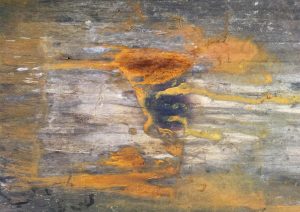
What I like about found elements is that they have been taken or are being taken from an earlier context - they already have a narrative trajectory, albeit broken. I find this notion of a broken or interrupted narrative trajectory is a powerful reflection of the ways of the world, where almost all stories start in the middle and end in another middle. Even in my digital works, I aspire to include found materials. For example in my VR installation “articulated subtext”, I suggest that the alphabet is the found source for the work. And my fundamentally digital films are 3d collages deploying multiple found analog and digital sources.
The (n)Atrocity Exhibition

BAF Gallery, Vancouver, 2017
The title riffs on a famous book from the 70’s by JG Ballard called “The Atrocity Exhibition”. There are many interesting things about this book. Highly recommended reading, not just for its seemingly prophetic insights to the digital age. Structurally, its kind of like a kaleidoscope, in that events are repeated from slightly altered points of view. The protagonists name for example, is not quite the same from one chapter to the next, and the same events are referred to in subsequent chapters, again from a shifted perspective. This fragmented kaleidocsopic vision is what inspired the structure of this folded wall construction I have made.
A second thing that is interesting is that over the course of the book, there is an erasure or fracture between what seem to be events playing out in the public realm and events that seem to happen only in a private realm, the protagonists mind. Are the described events memories or echoes of what has already happened? or are these intentions/desires on the part of the protagonist? In this exhibition, the fracturing wall is a shared memory of domestic walls, and also an unfolded/inverted delineating skin between public and private realms.
Also interesting is that the Latin root of Atrocity, refers to fire and seeing. Thus atrocity means “of fiery or threatening appearance”. It also shares a root with atrium, the open main court in a Roman house. I’ve added a playful conditional negation in front of Atrocity, changing it to (n)Atrocity. The exhibition itself isn’t an Atrocity, though indeed the physical construction may be of fiery appearance. Inside the privacy of the home - in our atria - we can become all too oblivious to the real atrocities that arise outside, somewhere else, in the public. Yet, via ubiquitous and portable digital media, such spatial separation is less and less relevant.
Willful Naivety
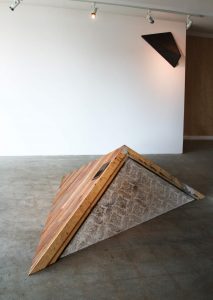
BAF Gallery, Vancouver, 2017
It's all been done before, so why do I bother to create anything?
I find I need to remain in a state of naivety, willfully so, in order to initiate, and create work.
Attempting to maintain this innocent curiosity - this improvised play - is important to the process and the result of a work.
Mark making
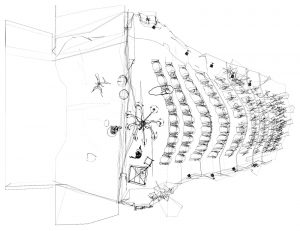
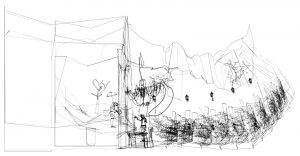
Like many visually inclined people, I have been mark making and drawing since I was young. Unconventionally, I have been drawing with computers for over thirty years. Often my drawings - whether digital or analog - are explorations or studies pointing to something else. Yet I am curious to explore drawing or mark making in its own right - for the drawing to be itself. I have been exploring dimensional drawings, and animated drawings, drawings that one moves around and through .
I have proposed a few animated city sized digital drawing ideas without success. I suppose the closest realization of the underlying premise is the upcoming Digital Aquarium , that will be a key cabinet in my upcoming Cabinet of (in)Curiosities project.
Acts of Construction, Acts of Destruction
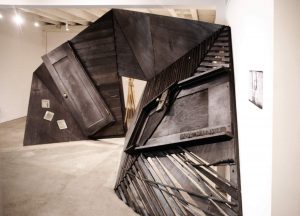
BAF Gallery, Vancouver, 2017
This BAF work in particular might be viewed as simultaneously a construction and destruction, as creating any inhabitable space is simultaneously a constructive and destructive process. Good examples are building site preparation and landscaping, the temporary use of concrete formwork, scaffolding, and such. As well, one could extend this to the materials of construction, like the harvesting and milling of wood, the creation of glass, concrete, metal etc. One could extend this simultaneity further to things like time (curing versus aging), and weather (drying versus rotting). Another layer of constructive and destructive tides is the way we inhabit specific spaces, which can often change over time. Renovating, birth of children, kids leaving home, making a space an income producer, clearing out, taking in... all such activities will change the space.
I think the rough-hewn or deconstructed aspect of much of my work - which I intend to be expressed in my digital as well as analogue works - arises integrally from my methods. Working with found materials, where I am viscerally attracted to the pattern, texture, form of pre-existing things - the interrupted processes and their traces; my embrace of improvisation, play, contradiction and complexity; my choice to charr the surface of the physical work; my embrace of non-sense and non rational logics; as well as relishing “the crack in everything”: all such stances contribute to an acceptance of allowing the work to be “itself”. Surprising, incomplete, in process, messy, rough, misshapen.
Also, like all physical works, collage and sculptural works have a context, they are not created in a vacuum. And if they are of a certain scale, this accommodation of a contextual system rubs up against real world limitations, which in turn instructs the form. The work needs to accommodate the reality of carrying the load of itself, which means dealing with gravity, tensile and compressive forces and the joining of and interfacing of materials. If the work is sited outside, one needs to additionally account for aspects like rain, temperature variance, wear and tear, unexpected human interaction. Such forces are simultaneously practical and conceptual.
A key difference between digital and analogue spheres is that many of the rules of these physical realities - such as gravity, weathering, weather - rarely apply in the digital realm. Or if they do, it requires another whole layer of digital craft and digital intentionality. As I did in other architecturally scaled works such as “Blow24fps”, and “falling: catching”, for this BAF work I have established an overall structural ordering system, which I am playing within and with. Physically, as well as digitally. Producing an unusual dynamic and friction.
Huckster's paradise
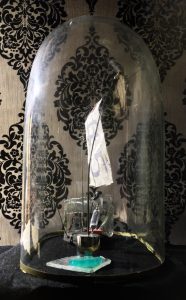
“Doctor Kali Gehry’s Cabinet of (in)Curiosities & Ecstatic Nonsense”, interactive installation, 2020
Located in a small town mall, this hucksters stand is selling nothing save an idea: that the voracious acquisitiveness that’s promoted through the capitalist project’s trajectory of making life better via purchasing is inevitably fruitless, if not bankrupt. Further, if we make an effort to consider more subtle resonances in our lives, it is within the cracks, within the refuse, within the rejects, within the moment-to-moments of unease that we might find a glimpse of meaning, a momentary respite from the (Absurd) foreknowledge of our insignificant mortality.
The project is a Neo-Neo Dada Kunstkammer taken for a walk towards illogical outcomes. The project sits somewhat uneasily between a dream theatre, an ark, a carny, a pirate booty, a gallery, a museum, an atrocity exhibition, a playground and a personal portfolio. Due to its recording of the specifics of locality, the project can also be viewed as a mixed media portrait: of me, of my ancestral proclivities, and of a larger community’s place and time. Like the classic Cabinets of Curiosities, this is a work of cultural propaganda. This cabinet is a bewildering, heterogeneous array of insignificant things, an extended work investigating some ever-present relationships between my art making, film practice and exhibiting expertise.
If, cumulatively, the historical curiosity cabinet was a colonialist map of the exotic, mysterious and conveniently not-known, one of the intentions of this cabinet is to throw a monkey wrench into such convenient considerations, stimulating ripping yarns (as in “thrilling stories”) of possibility riffed from largely indiscernible yet decidedly modest sources. This cabinet’s various things’ significance arises not from their inherent exotic ness, but rather from their inconvenient selection, their assemblage, their arrangement in the cabinet, their mise-en-scene and their mise-en-place. The cabinets are important by virtue of being on display in this cabinet at this particular time in this particular place.
Random Thoughts on Creation
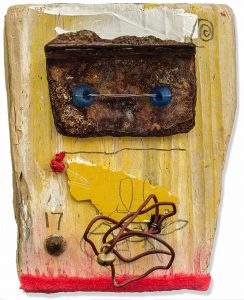
I’ve little interest in the pristine object.
Or the “heroic” art gesture of originating all aspects of a work. I’m most intrigued by working with found materials and objects. Including digital.
The virtual has proportion, scale, perspective, colour, etc. But no gravity. This weightlessness allows for unrealistic makings, which further intrigues.
Improvisation and play are the generators of my work. Experimentation too, but less a scientific method repeatable way, more experimentation as in taking a line for a walk.
2 dimensionality doesn’t really exits for me. The most extreme of graphics - black forms on white BG, I read dimensionally. This is best exemplified by my “3d strokes (after motherwell)” work.
Colour also has depth, as demonstrated by Rothko.
The fundamentals pf physical structures are analogous to a chiropractic view of things - compression (skeleton) and tensile (muscles/tendons) forces combining together to align and move in defiance of gravity.
My "craft" is at the scale of architecture, not so much at the scale of furniture.
Since architecture school, it is the affects of time and the movement through space, that interests me. In this sense, I believe my works are more about choreography than plans.
The only true and unavoidable site for physical works is our skin. In order for this site to be an opportunity, one needs to shift from it being the site of self loathing to one of play and experimentation.
Every part of my work has significance, I just know little of what the significance is.
The logic of chance
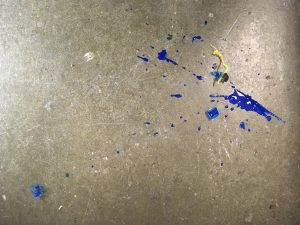
The logic of chance and serendipity are integral to almost all my work in that they are integral to the collage process, and I consider myself in essence, a collage artist. In bringing together a collage work, I seize upon accidents, and the resonances or dissonances that may arise between juxtaposing materials, which are themselves, oftentimes, found. The very nature of acquiring such materials is serendipitous. As I joke, the tidal shoreline is my favourite art store.
In collage, the found stuffs are re-contextualized from their previous spatial-temporal reality, set beside other re-contextualized elements, and something new results. Whether it is resonant is as much to do with serendipity as design. For this BAF work, almost everything I am using as source material for the wall’s construction is found or has had a previous application. (The exceptions being the non-reusables like glue, brad nails, propane etc.) Before starting I know that as i’ll be working with re-purposed building materials, there will be variation in size, physical condition, usability etc. Such unpredictable realities has a knock on effect. I need to remain flexible, adaptable. Be improvisational. Serendipitous.
An additional layer of serendipity arises during the charring process, where different densities or finishes of material respond differently to the flame.
All such unpredictabilities are welcome to me.
I think what attracts me to working with found materials and the collage methods is that I don’t much care to have “my hand” be front and centre of my creative process. i find myself falling in love with a piece of garbage as easily than a drawing from my own hand, for example. To me, the found stuff is equivalent to a created element. The advantage of the found/acquired element is that my ego isn’t in the way.
Digital Crafting
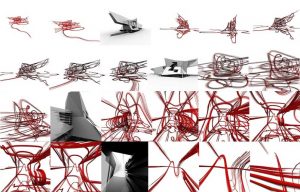
People can misunderstand digital methods as being “craft-less”. At its most basic, there are essential characteristics of craft in programming, especially good programming: finesse/refinement, repetition and variation, attention to detail, singular expression within a larger system, utility, working the material to your ends, etc. This is before one considers how the likes of me, a non-programmer, interact with computers, most often through an advanced GUI (graphical user interface), which hides the command lines in the background. As someone who is visually driven, I am oftentimes inputting and manipulating material via pressure sensitive pen and tablet, which allows analogous control to a pencil/pen/paintbrush. Of late I have been exploring finger and spatial gestures, and voice activation. Further, 3d modelling and animation techniques, which are essential to all phases of my creative practice, I would argue are more effectively realized - “better crafted” - than is possible with their analogue counterparts.
The Resonant Possibility of the Absurd
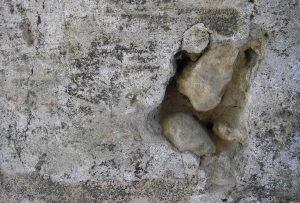
Towards an Artistic Strategy in Psychiatry - inarticulate, non-sense surmisings on the resonant possibility of the Absurd , spring 2017
(This text was the basis for my application to the Van Abbemuseum and the GGzE (Mental Health Care Institute Eindhoven) Artist in Residence Programme “Artistic Strategies in Psychiatry”.)
...alongside my own intimate brushes with death, got me reflecting back to salient readings from when I was a younger man. To the perspective of one of the elders of Absurdity, Albert Camus, who presented the idea that there is only one philosophical question in life: to take ones life or not. Essentially, all other philosophical subjects are evasive. His younger contemporary, Georges Bataille, speculated that there were two essential human subjects, sex and death. (Interestingly, with eroticism being the link between the two solitudes.) In my life, I have correlated this to the essence of Buddhist teaching wherein all uneasiness/angst in life can be attributed to craving (of what is out of reach) and aversion (of what is in front of us). These threads form one of many roads into the cul-de-sac that is my essential artistic stance: that to be conscious and resilient to gravity in the world, to varying degrees, we suffer from what I phrase as “nostalgia for the future”. That is we over-fibrillate between a past that is no more and a future that may never be, suffering from homesickness for what has yet to happen.
Its Absurd.
Remember the bumper sticker that says: “To be well adjusted to a profoundly sick society is no measure of sanity”?
One of my personal calibrations is what words should I present to support what I am up to artistically. As there are no longer any over-arching cultural narratives, Art seems to be ever more contextual and relative. I try to not get overly worried about what words I arrange and in what way. I try to remain playful and in the moment in my phrasings. despite the fact that at some basic level, i believe ones visual works should speak without a rationalizing context text, the currency of artistic discourse seems to be becoming ever more heady/nerdy/self justifying.
As I mentioned, I have two projects that are coming together in the next months. The centrepiece of one is an installation with three interactive Absurdist portraits - “Circling Towards a Possible Present, interactive portraits of dead people you don't know or care to”. This is presented in a storefront in a small town shopping mall - a neon sign above the threshold, a burned exterior, crushed rock on the ground, plywood walls. And the second is a physical installation of a simultaneously charred n preserved, unfolded, upside down and inside out domestic wall, that is extended into an infinite labyrinth via Augmented Reality (AR) overlays, “The (n)Atrocity Exhibition, a house crash for the rest of us (or all the things left unsaid between the twins)”. This second project is part of a 10 week artist-in- residency and exhibition during which I am exploring some similar themes to what I hinted I might explore should I have been accepted to the Netherland gig.
~
For many of us lay people, psychiatry is a difficult subject. Discussing it remains taboo. At the risk of gross oversimplification, perhaps a root cause of many psychiatric episodes is the profound, rupturing realization that there are no absolute answers to life's fundamental questions, and that the essential modern human condition can most aptly be described as Absurd? One might say that Absurdity sits in opposition to the efficacy of Psychiatric Narrative. Perhaps definitive narrative answers are unrealistic, if not disingenuous, to those of us whose psyches are vulnerable.
Maybe our societal narratives of sense-making - such as:
• belief in an afterlife as cover for a more innate fear of death,
• the presumption of linearity in space and time,
• the disconnect between work as performed and its effects on the world,
• belief that family have your best interests at heart,
• belief that social media assist communications,
• belief that one can relax in front of the TV/computer/social media laden device,
are each vulnerable to the scrutiny of an Absurdist gaze.
Further, we are distracted to an almost perpetual state of un-ease with the world, irrevocably torn between the past and future, fibrillating, always avoiding the here and now, unable to remain present.
Is there psychiatric agency in the embrace of the Absurd? Might it reveal an empathetic, relevant, present,“psychiatric artistic strategy”?
Psychiatric doctors & therapists are the conductors attempting to present narrative order amongst the existential evidence of a disinterested universe. They have replaced clerics in shepherding our psyches. As I understand, psychiatric intervention may be warranted when someone, whether triggered by an event, stress or neuro-chemical reasons, is unable to be sufficiently coherent in responding to the inevitable vicissitudes of life according to the prevailing expectations of society. Curiously, characteristics such as independent questioning, a determination to go it alone, defy norms and expectations is respected in artists and poets. “Creative vision”, “artistic frenzy”, “inspired” artistic ideas, have their psychiatric equivalents in delirium, manic and delusional behaviour. In addition to the descriptive language used, perhaps a key difference between an artist and a non-artist who are experiencing similar mental disfunction may be that the artist gets a grounding from the purpose, structure and community via their vocation, as another might from their faith.
I see myself as an editor, a chooser, a “mise-en-scene-ist”, vs the more heroic notion of an artist as a creator of something from nothing. Instinctively, I draw upon diverse creative strategies where an Absurdist perspective is either put into action, or which shares an embrace of the inscrutable and an intention to heighten the present. I am interested in how chance, editorial, improvisational, craft, and mise-en-scène processes may be agents of sense- making. I’m interested in working collaboratively, improvisationally, curious about the implied psychological imprint of various, largely found, source materials and how, reconfigured, their psychological impact might manifest.
Of late, I have become interested in the visceral primacy, cross cultural richness and diagrammatic power of the maze/labyrinth. Reflecting on what I can glean of the GGzE facility, program and clientele, I would be curious to explore the counterintuitive possibility of the maze/labyrinth as a way-finding device, as a means to get oriented, to get centred, to become present, to come home. A physically engaging catharsis.
Mazes and labyrinths exert powerful double readings as both their enigmatic selves to be experienced, and more imaginative speculative readings. On a basic symbolic level, traversing these constructions is a quest, heightening the present, a journey from here to there to reclaim knowledge or overcome adversity, followed by a return, and being transformed for the experience. They can be simultaneously understood as a metaphor of life experience and a conundrum to be “solved”, wherein the essential action is one of returning home transformed.
I’m curious to explore how losing & finding ourselves physically might connect with ideas of psychiatry and finding ourselves mentally, possibly making the Absurd seem momentarily less so. I wonder if we started with this metaphorical subject, would my creative process - a mashup of absurdist proclivities - reveal resonances on a possible “Absurd” root of mental illness?
Spatially Interactive 3d Portraits
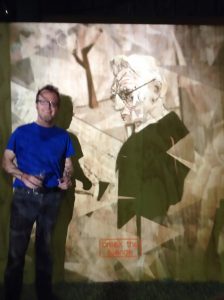
Circling Towards a Possible Present is a new media installation consisting of three interactive, game-engine driven and on-the-fly rendered figurative portraits. The project sits at the intersection of portraiture, film, theatre and video game traditions. It plays with and subverts the expectation of portraiture & interactive 3d games, while considering the inherent theatrical, filmic and painterly dimensions and expectations of these mediums.
The three individually styled portraits share underlying technology and presentation - iPad controlled interactive 3d characters in a fully 3d environment connected to projectors in a bespoke space.
This work welcomes one to come in, slow down, and play in the present. These re-imaginings of portraiture pay homage to the legacy of and embrace the perspective of Absurdity. For me, the absurdist perspective implies returning my focus to the elusive and illusive present in order to observe and deal with whats truly in front of me, that is, the all caps subtext of mortality.
I presented this work as a pop-up store in a shopping mall in the small seaside town of Gibsons, BC. Located in a busy area in front of a Liquor Store, with a Lotto Kiosk in between, the solid plywood storefront was dramatically charred, with the doorway cut into it on a diagonal. The “store” was signified by a cursive neon sign spelling out “circiling towards a possible present”. The ground of the 20 foot by 20 foot room and the small threshold leading to it was lined with crushed rock. When the public moved past the charcoaled facade and entered the projection room, they became very aware of their movements as their footsteps on the rock were amplified by the room itself acting as a rudimentary speaker. Demonstrably, this unusual soundtrack made people more aware, even reverential, of their inhabitation of the space. Each of the three portraits were presented simultaneously on tablets and video projectors, allowing the portraits to be presented as life-size.
In the age of selfies/facebook/Instagram - this age of unstable, real-time evolving, personal narrative - is portraiture dead? What affect might the ever more retinal, immersive and responsive gaming technology have on portraiture? If “a portrait of a dead person” can always be changing, moving and responsive to a users requests, is it still a portrait? What affect does differing mise-en-scene have on subjects that are approached with the same UI and that move according to the same animation loops? Does mise-en-scene change the possible reading of the subject and their motions?
Through the three portraits varying presentation, I am attempting to run as quickly and as far as possible away from the 3d game industries bias towards retinal realism and action based first person shooter subject matter. In a paradoxical way, these portraits bring the dead medium of portraiture to life through the gaze and nature of their animate, spatial, 3d dimensional game engine digital sources. However, I am undermining this technological trajectory by choice, design and flaunting of conventions. For example, through the portrait’s subjects themselves; the unwieldy first person point of view; infidelity towards Cartesian space; unfixed narrative; unusual framing; unpredictable loss of first person control recycling & re-contextualizing pre-existing “found” elements, including animations, textures and models; super slow motion loops of movement; inappropriate actions; random and inexplicable events; seemingly nonsense textual buttons that trigger ridiculous movement loops; etc.
Blowing 24 fps
Blow 24fps * is an investigation into the nature, properties, and versatility of found wood and wood products.
It is an exploration of surfaces - the pattern, texture, and material qualities of 24 wood panels becoming at once both canvas and painting.
It is an exploration of spatial and temporal movement, the panels re-shaping, carving, re- delineating the familiar facade and space of the GPAG entrance canopy and its presence on Gibsons main street.
It is an exploration of revealing, unwrapping, turning over and inside out. A kind of wood forensics. For most of the panels, interiors are presented to the exterior, what is largely private flipped into the public - exposed flooring and wallpaper covered shiplap, the non- exposed surface of siding, the inside of a cardboard box and a packing crate, unfolded cabinets, and the back turned on a clock.
Unlike typical fine woodworking, this is wood play at a larger scale of craft, more to the scale of architecture than furniture. Its a playful construction - a construction of panel and structure. And the construction of 24 “frames” of change in the assembly of the animated loop.
The story fragments are curious - the legacies of these reclaimed wooden artifacts are part of their fabric, oftentimes written directly into them.
~
And the whiff of Crow - evidenced as an ephemeral progression of shadows, singed into the pores of the twenty-four wood panels. Trickster. Shapeshifter. Clever-one. Where to?
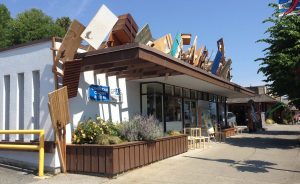
Blow 24fps* consists of 24 found panels, cut to 20” x 40”, made from found plywood, old doors, floorboards, barnboard etc. with a 2” x 4” structure of found lumber. The installation was part of a larger exhibition on the “art of wood”. A blow-torched (flame-burned) animated crow was burned in the lower left corner of each panel. The panels are arranged or “animated” as if blown up onto the roof of the classic Modernist ex-bank building gallery.
*24 fps refers to twenty-four frames per second, which is the standard frame rate for one second of film.
Guest Post by Axel Fussi
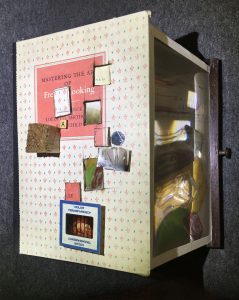
A Perspective on the Cabinet of (in)Curiosities, by Axel Fussi
"This is what is known as perspective, and it is a swindle...." Kurt Schwitters
The unique format of Doctor Kali Gehry’s Cabinet of (in)Curiosities & Ecstatic Nonsense provides for a dynamic and momentarily baffling field of contemplation, interaction, and interrogation that invites an audience to ask questions about what and how they see. In this Neo- Dada work, these nonsensically reconfigured objet trouvés create, as André Breton put it, “veritable slits in time, space, customs and even beliefs.” In this sense, this cabinet is intended to be by turns affirmative and interrogative. In doing so, the spectators begin to interrogate their very relationship with the Cabinet’s collection, and, therefore, themselves.
This cabinet is architecturally mutable, a pop-up of discards, housed intermittently in local Low Street shopping malls, neglected Main Streets, interstitial commercial, institutional or public spaces. Though the cabinet’s architecture seems poised, simultaneously it seems at the risk of tipping and sliding toward instability. The individual cabinets themselves are stable and level, with their contents seemingly arranged to whim - paradoxically linked by the absence of any discernible link. Like Schwitter’s Merzbau, it is a chamber whose construction and commencement of destruction are indiscernible, an endless laborious production and self-effacing unmoored from any claims to a definitive outcome.
The work deploys an organizing principle of movement, collision and juxtaposition, where one’s perambulating and shifting gaze sequence the exhibition as it unfurls, inviting an intrinsically variable interpretation of the work’s significance. A seemingly absurd individual thing surprises by revealing its agency within the peculiar grammar of the collage precisely due to the contingencies and juxtapositions of an infinite number of combinatory possibilities it is exposed to. One wonders about the cabinet contents’ aleatory provenance, the chances of these object fragments being seen and picked up by the artist, their seemingly arbitrary mise-en-scene and mise-en-place, indiscriminate of any assertions of completion.
Though the re-exalted contents of this oddity store are not for sale - thus questioning their value, if there should be any at all - the curating restores what many would simply see as refuse to a more refined status of significance. As signs, visual metaphors, in tandem with their aesthetic uniqueness, and residual significance, these fragments of detritus are still identifiable – their origins largely traceable to their former contexts. Yet, when isolating and alienating these object fragments from the rationality and legitimacy they derived from their “native” context, once recombined, they reveal their surprising inherent and emerging, yet nevertheless absurd alliances.
Via the exhibits' explicit framings, portals, screens and illuminated lenses, we are led back to the idea of Point of View, the very root of perspective, as a human-centric view of things, with the world converging in and radiating from its inevitably banal centre. Spectators are thrown back on themselves, by becoming involved in this rather confusing and disconcerting process, since the world’s order is jarringly disrupted. For the audience, this loss of perspective ineluctably entails finding themselves in the present, in the here and now.
Being present in the presence of these momento mori constructions, we are challenged to confront the ephemerality of things, and thus the vanity of our own existence. This is similar to being presented with a Koan, the old hat trick of Zen masters, handed with the intent to blow all rational constructs of “truth” in their disciples’ minds to smithereens, and thus open their hearts to the unspeakable.
About My Cabinet of Incuriosities
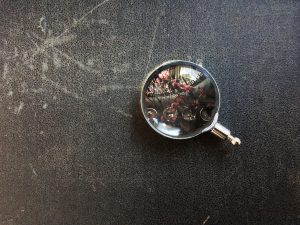
“Doctor Kali Gehry’s Cabinet of (in)Curiosities & Ecstatic Nonsense”, interactive installation, 2020
In my view, what is truly radical today is to intentionally stop, refuse, resist, do nothing save remain in the moment. To be. To be present. Which means be present amongst the evidential detritus of our merely human condition. It is in this radical spirit of doing nothing save be present that this project was conceived.
As developed during their Rennaissence to Victorian heyday legacy, “Cabinets of Curiosities” or “poetic theatres” or “memory chambers” were the private amusements of eccentric aristocrats and the materially focussed nouveau riche. They were proto art galleries, proto natural history museums, and random memorabilia collections of questionable provenance. I have also come to view such private museums as proto visual encyclopaedias, open ended “interactive” puzzle games, and devices for seeing.
Like Cabinet’s of old, this Cabinet is an instrument of perception, an optical and philosophical device for framing a world view. Perhaps also like Cabinet’s of old, this instrument, this propaganda device, is intended to be both calibrated and played, without beginning or end. Unlike Cabinet’s of old, this instrument’s world view is actually a local view, and intended to be interruptive, discursive, elegiac, incongruous, irreverent and mischievous.
This travelling and evolving work is a bespoke, pop up shop that re-presents fragmentary refuse and scrounged artifacts, evidence of our contemporary lifestyle. These “memento mori” discards are elevated up onto a commercial pedestal, though nothing is for sale. The project’s architecture and its contents are changeable, improvised, its footprint scaled up and down depending on space and material availability. The project will travel with a number of individual exhibitions, including the interactive sound, digital video, projections, and AR components and their supporting technology.
Much like in film, in presenting these largely unrelated series of mise-en-scènes, I am shaping a sequence. Cumulatively this montage logic creates a narrative. At varying moments, this story is supported or contradicted within the frame or larger Cabinet.
I am prescribing the point of view, determining these Alberti-an windows-on-the world, choreographing the revelation of the always partial stage. I am the director of this bonkers theatre of the absurd, the sh(ad)owman, the Carny tempting you.
And by entering, dear viewer, you become a player, complicit in my absurdist intentions.
Tiny Houses
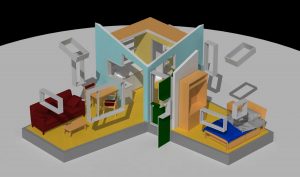
Last year, I was introduced to the amazing Sharon Lee at Seattle's LIHI (Low Income Housing Institute). A year before we met, LIHI had started to pioneer Tiny House Villages as a rapid response to the ever more concerning homeless situation in our cities. As permanent housing takes some +/- 5 years to get financed, sited and built, LIHI proposed these Tiny House Villages as an interim housing solution that they could have up and running 4 months after agreeing a site. Fantastic stuff.
I thought I could make a contribution to the design of what were essentially decorated sheds, by thinking of them as architecture. My view was, these tiny homes needn’t be the lowest common denominator storage boxes - lets make manifest through architecture, a representation of the possible, of the hope for things to come.
There were a few key architectural actions we could deploy that I think would improve the psychological efficacy of these sheds, without adding too onerous a cost increase. Namely: adding a skylight, planting a tree associated with each unit by pulling in one corner to create a sliver planter, cutting the front door in two, and creating a wee stoop. These ideas didn't get very far for a number fo reasons, notably that LIHI were already having great success creating these Tiny House Villages, so there was no need to break the formula.
Instead, I was invited to be involved in the design of a new LIHI venture, a Tiny House Cottage. These were going to be comparatively large (+/- 300 square feet vs 100 square feet) and permanent. Aside from their modest size, the other key idea for keeping the costs down on these Cottages is that they were to be pre-fabricated with high school students and trucked onto a, on-site poured slab. A nice design problem to be sure.
See my LIHI Cottage Design Presentation.
Some guiding design ideas - how to move them from being houses, to becoming homes
- Closing the door/being safe
- New constructions, needn’t automatically be conceived of as mere 8’ high boxes. (To be clear, I don’t advocate for the complexities of curved walls or roofs. Rather, i’m advocating for non-orthogonal spaces and form. Tapered rooms - sense of expansion/compression . leave space on the side for a small garden within the plot. -> its not a box!)
- Include a skylight - not an extra. Having an ongoing visual access/axis to the sky is important for us all. Aspirational, promotes reaching, dreaming, possibilities. and yet the ever present light, is grounding and promotes connection to the earth.
- A house & garden together, a garden is not an extra. (plant a tree with each house, in the spare wedge of the layout)
- Shed roof’s are economical, functional in this Pacific Northwest rainy temperate climate. And if reoriented, they provide interesting spatial and shelter opportunities.
- Needn’t be symmetrical - Move door off centre - rather than two equal inadequate spaces, you have one more useful space.
- Tiny house villages, needn’t be orthogonally arranged. instead, arrange them loosely, crookedly, possibly in pairs or groups of three, with an overall logic of a circular path among the houses.
About Walls, Fences and Barriers
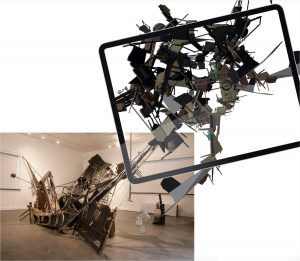
This work is a temporary, multi-part, improvised installation, an assemblage made of two realities - physical and digital. The work makes fun of our propensity for barriers. This is a domestically scaled fence/barricade made from reclaimed and reconfigured furniture that is cleanly and endlessly extended by an Augmented Reality (AR) overlay made visible via the built-in cameras on the provided tablet.
Like walls, fences become more ineffectual as they move further from their typical vertical orientation. When compromised by gravity, they need to be propped up, provided with a crutch. Crossing this tipping point from resistance to gravity, they become doubly useless, their “wall-ness” is compromised and they are in the way.
Delineated borders/walls remain potential flash-points in communities all over, oftentimes highlighting a separation between public and private, between “haves” and “have-nots”, between “mine” and “yours”. For this ridiculous, seemingly animate work, there is nothing being kept out - there is no “here” being separated from “there”. Further, with the digital AR overlay, the threshold between the real and the virtual is questioned.
Getting in the way, recalibrating intentionally compromised forms and the implicit choreography of such actions became the central focus of my residency.
In its irregular capricious placement, its ineffectual source material, its semi-charred ruinous state, its never upright orientation, its submerging and emerging character, its intentional un-constructed/re-constructed methods, cumulatively this work strays far from utilitarian conventional barriers. The work is simultaneously a genuine and false ruin, its factual partial presence implying and extending into a virtual fictional whole. The work is a reminder of the transient nature of earthly pursuits.
http://matthewtalbotkelly.com/portfolio/concerning-the-inept/
Articulated SubText
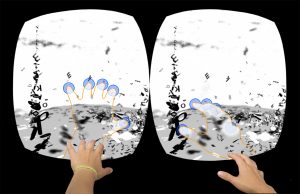
articulated subtext conceptual diagram, 2016
I love letters, text, symbols and numbers.
I love their graphic precision, their associations, their architectural possibility of structure and collapse, their endless capacity to be reinvented and reassembled in both poetic and nonsensical ways. And when lifted from the page, made animate, they easily slink together in watery ways. In my works, I keep returning to three-dimensional, ordering and disordering text as an apt metaphor for our media overloaded contemporary times.
Rather than choosing to create a literal representation of water, this project focussed on a more interpretative and dynamic understanding of what “water” and “fluidity” and “swimming” and “buoyancy” might mean. The piece presents a “watery” experience. This project demonstrates how we might understand the continuous and cyclical dynamic of fluids as being analogous to language, thoughts, memories. In the same way that one swims through a body of water, each of us is, consciously or not, always swimming through a fluid stream of memories of the past and thoughts of the future.
The privacy that is necessarily provided to the viewer by the virtual-reality goggles is paralleled with the private way in which each of us is left cycling/swimming through our memories on our own - no one can join us in this swim! The apparent nonsense jumble of the text that the viewer swims through seeks to playfully remind the viewer of not worrying too much about “sensical” memories, since they too are constantly ebbing, flowing, changing....
Car Accident
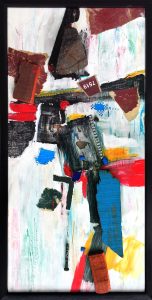
Newfound Presence
My car accident plays an influential role in my practice in that my brain, in particular my memory, is messed up. My memory is a bit like Swiss cheese, with holes, with chunks missing or inaccessible. I have yet to note a discernible pattern to these gaps. Sometimes, I can recall events of my childhood with some clarity, but have no recollection of a birthday from last year. Or sometimes, as I am up and moving to another room for something, along the way, I forget what I am going to do.
While this may seem a negative outcome, a positive outcome of this reality that more than balances things out from my point of view, is that I dwell in the present more. I am able to sustain such presence longer as psychic clutter from the past or future doesn’t as readily enter my sense doors.
This in turn, reinforces my meditation practice.
Blind Man’s Eye
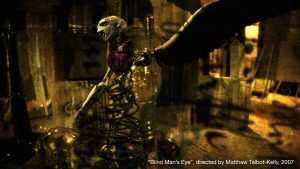
This is an experimental film in that a primary motivation was that I wanted to explore movement through and around three dimensional collage. Or I guess one might say, create four dimensional collage. I had done some 3d digital experiments whereby I was applying out of scale unexpected textures from real world sources onto architecture and urban form - things like hand written letters, dictionary pages, newspaper clippings, photos of people and things etc. I broke-up the regularity of the streets by including scaled up tea-cups, tricycles, letterforms, and such. In addition, I scaled things like fire hydrants and glasses up to the scale of buildings, and scaled down things like buildings to be the size of furniture or mementos. As well, I embraced that in a computer, there is no gravity. Thus a pair of spectacles can be enormous as well as suspended in mid air.
These experiments were interesting visually, but also, conceptually, I was taking material from the intimate and private realm and exposing it for the public realm. This worked for me, helping me visualize what I call psychic architecture.
Another impulse, ironically, was to get off the computer and make things by hand, using paper and wood and paint and such. Crafting if you like. And by camera recording these hand made bits, celebrate all the material and textural variety, the imperfections, and surprise that come from doing collage.
Narratively the film was intended to be less a linear unfolding storyline, and more a loop of sensual immersion. In my mind, the subject blind old man is willfully blind, having decided to tune out the external visual overwhelm, in order to return to his box of memories. Subject wise, it is this “insight” of the “psychic architecture” I wanted to convey - in all its non-linerarity, complexity, juxtaposition, and contraction.
Watch the film here:
https://vimeo.com/191322874
Foot of Main Salon
This salon was a fond time, with my good friends Giorgio Magnanensi and Erik Whittaker.
Below is a propaganda page I designed for the event. Good times indeed.
